Although Austria is one of the smallest countries in Europe, its central location and especially its influential past make it to the heart – or maybe the solar plexus – of the continent.
Austria’s capital Vienna is looking back at an everchanging and compelling history. Whether it is the Congress of Vienna where Europe’s layout and faith were determined after the Napoleonic wars or the powerful Habsburg dynasty including Empress Sisi and her tragic faith. Since the gilded years around the turn of the 20th century, Vienna has been the center of the artistic and intellectual avant-garde. Progressive painters like Egon Schiele, innovative designers like Koloman Moser, inventive architects like Otto Wagner and Adolf Loos, exciting musicians like Arnold Schönberg, and of course the father of psychoanalysis Sigmund Freud made a compelling case for the city’s glory.
Amazingly, you don’t need to join an expensive city tour to explore all the wonders this extraordinary city has in store. Basically, all the magnificent and world-famous landmarks in Vienna can be easily and inexpensively visited by a public streetcar!
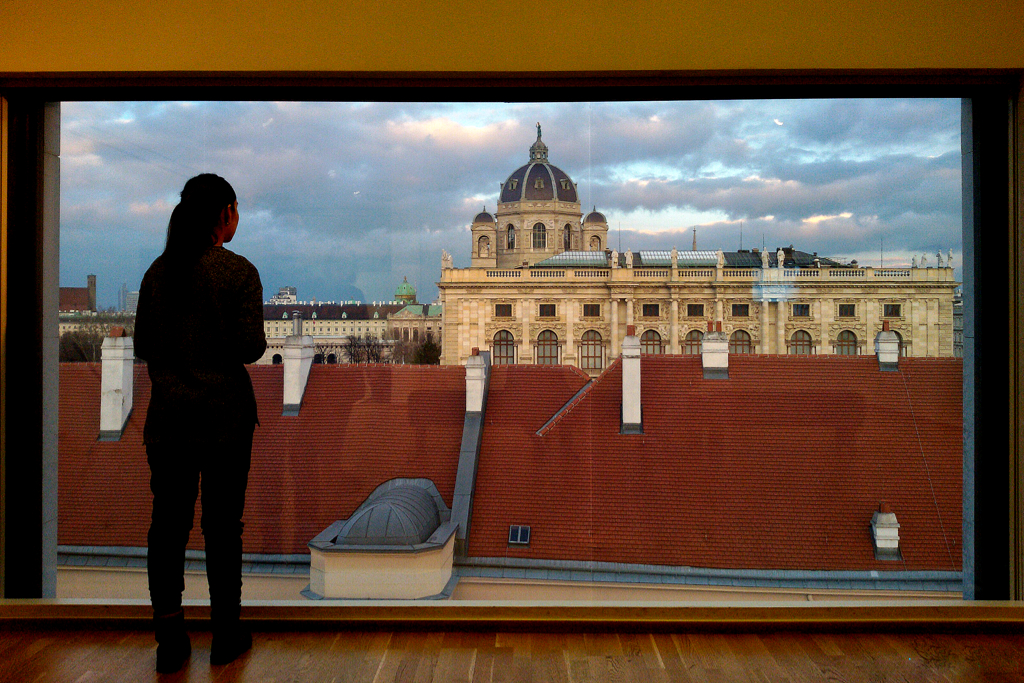
So hop on, let’s explore a city full of history, stories, and myths!
Vienna
Austria’s charming capital Vienna is one of Europe’s historically most influential and definitely most beautiful metropolises. It is home to more than two million inhabitants which is actually over a fifth of the country’s population. Although Vienna is the second-largest city in Europe’s German-speaking region and actually the fifth-largest city in the European Union, the city has lost none of its lovely, fairytale-like, majestic charm. You can find the rich heritage of the Habsburgs on every street corner in Vienna. This is mainly reflected in the historic center which is listed as a UNESCO World Heritage Site, albeit with the magnificent palace of Schönbrunn.
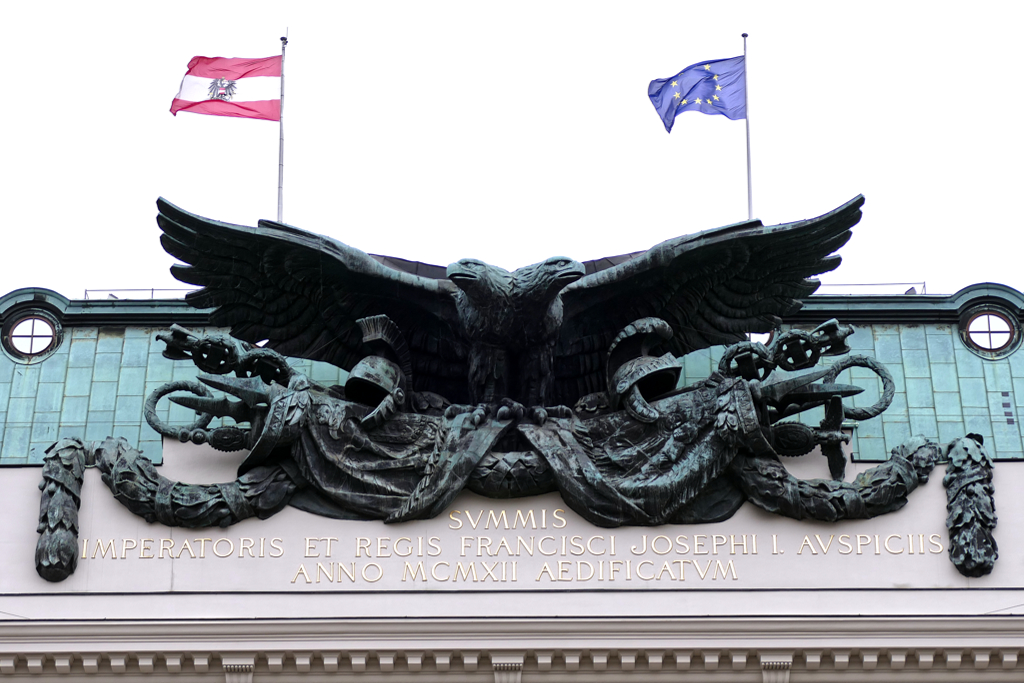
The Habsburgs’ glory began with Rudolf I’s victory over Ottokar II of Bohemia in 1278. Prague, another jewel among Europe’s culture-rich cities, became an imperial residence under the Luxembourgers, slightly overshadowing Vienna. In order to be able to exist alongside Prague, the early Habsburgs tried to expand their seat of power.
Europe’s Cultural Powerhouse
The beginning of the 18th century marked Vienna’s heyday. The city of Vienna developed into an important European cultural center. Composers such as Mozart, Beethoven, and Schubert still represent the importance of classical music in Vienna today.
In 1804, Vienna became the capital of the newly created Austrian Empire. Its role as the Austrian Empire’s imperial capital and residential city made Vienna a cultural and political center of Europe. During the Coalition Wars, Vienna was captured twice by Napoleon’s troops. After the victory over Napoleon, the Congress of Vienna took place in 1814 respectively 1815, which reorganized the political situation in Europe.

It is one of the most important historicist and best-preserved palaces on the Ringstraße.
Architecturally, Vienna is still characterized primarily by the buildings around the Vienna Ringstraße from the Wilhelminian era. Also, there is a strong influence of Art Nouveau and Viennese Modernism of the Belle Epoque.
With the beginning of industrialization in the middle of the 19th century, Vienna experienced an enormous increase in population. In particular, immigrants from all parts of the Austro-Hungarian Empire, especially Bohemia, made Vienna a cultural melting pot. However, this also created a working class that was sometimes very poor. Their political influence made social democracy stronger.
Tables Turn
At the turn of the 20th century, the city experienced a new cultural peak, that of the aforementioned Viennese Modernism. What we see as lovely and ornate today was downright revolutionary back then!
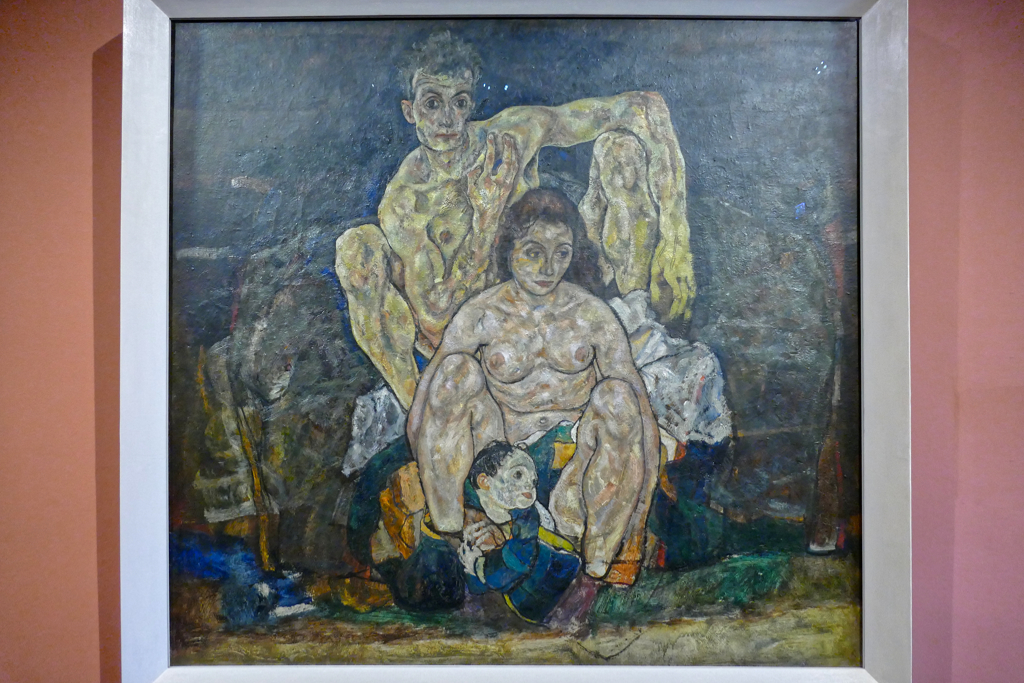
The Secession Artists’ Association made Vienna a center of Art Nouveau. But unusually dissonant tones were also heard in music, especially in the circle of artists around Arnold Schönberg. Modern literature was discussed in the city’s many coffeehouses. In this open, almost revolutionary atmosphere, Sigmund Freud created psychoanalysis. Everything was new and daring and exciting.
The end of WWI also heralded the end of Austria-Hungary and with it the end of the Habsburg hegemony. The new state of Austria came into being on October 30, 1918.
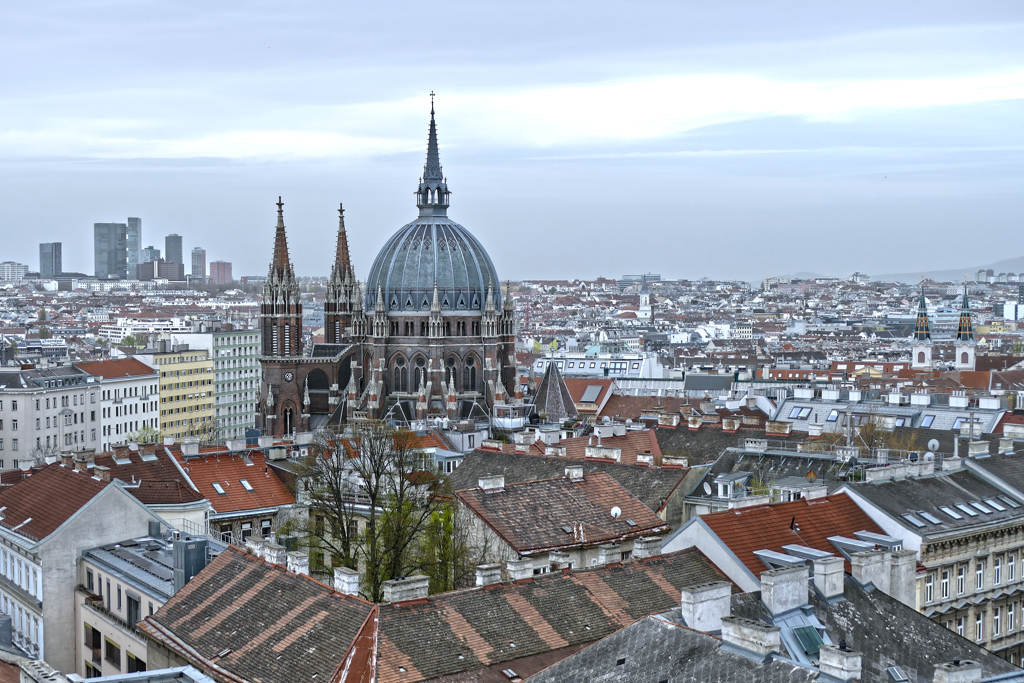
The city had already played an important role in international diplomacy during the Congress of Vienna. This continues to this day. Vienna is an internationally important conference location where more than 40 international organizations such as OPEC and the OSCE have their headquarters. After all, one of the four official headquarters of the United Nations is in Vienna.
So you can see that practically everyone can find something that suits their interests in this incredibly diverse city.
Visiting Vienna in a Perfect Circle
I go to Vienna almost every year and it never gets boring. The mesmerizing beauty never gets old, and there are always some exciting exhibitions to visit. Also, as a very dear friend of mine is lucky enough to call Vienna her home, I get tons of tips on what to see off the well-trodden tourist trails.
So let me take you with me on a special Vienna tour. Yes, we’ll do this hop-on hop-off thing, but we won’t break the bank. We’ll do a lot of walking, but we also take Vienna’s wonderful streetcar. It circumnavigates the entire historic center and stops at some of the most important spots. However, you’ll also discover some hidden gems.
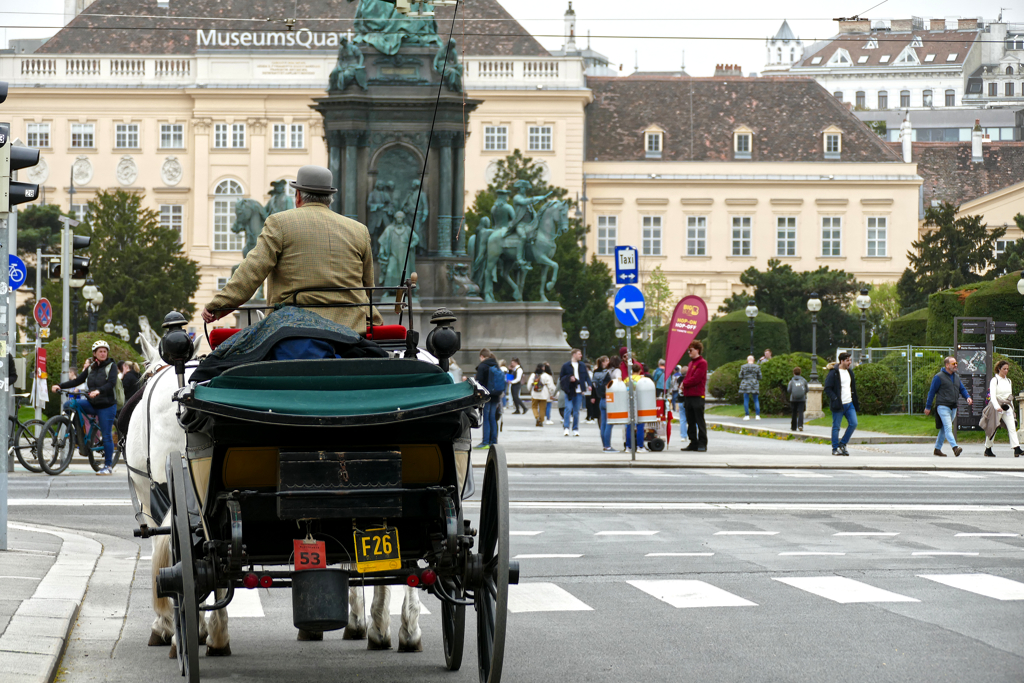
Up until not long ago, there was the touristy Ring-Tram. For 9 €uros, it went full circle in about 30 minutes and included explanations in different languages. The service is currently suspended. Since it was just a round trip without a hop-on hop-off option, the regular tram is much better anyway.
Which Ticket to Choose
If you only want to ride around the Ringstrasse just once, it’s best to buy a one-way ticket for 2.40 €uros. With this ticket, you can travel for 80 minutes in one direction, hence, it’s not good for a return trip. However, within these 80 minutes, you can hop on and off as much as you please as long as you continue in the same direction. However, if you’re planning on taking the means of public transportation a lot, a day pass for 8 €uros might be a better deal.
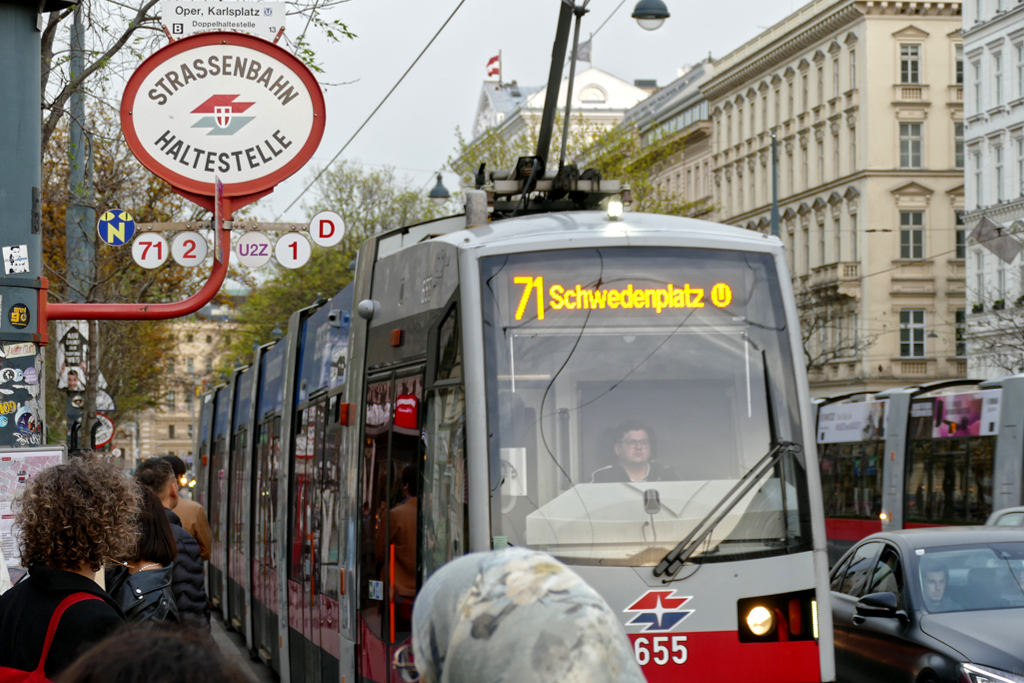
To travel in a complete circle, you have to travel on tram #1 from Karlsplatz all the way to Schwedenplatz. There you change to tram #2 for the remaining five stops. Don’t worry, I traced it on the map below.
Around Karlsplatz
Karlsplatz is the perfect place to go on a tour of Vienna for several reasons. On the one hand, it is very centrally located. From here you can take a short walk in all directions, and you’ll discover something interesting or exciting. Obviously, it is also a central hub in terms of public transport: Three of Vienna’s five subway lines intersect at Karlsplatz station, and various tramlines also stop here or at least very close by. And thirdly, there are so many not-to-miss landmarks around the square that you could spend almost a whole day here without getting bored.
The square was named after Emperor Charles VI in 1899. During the plague epidemic, he vowed to have a church built. Therefore, the Karlskirche was completed in 1737.
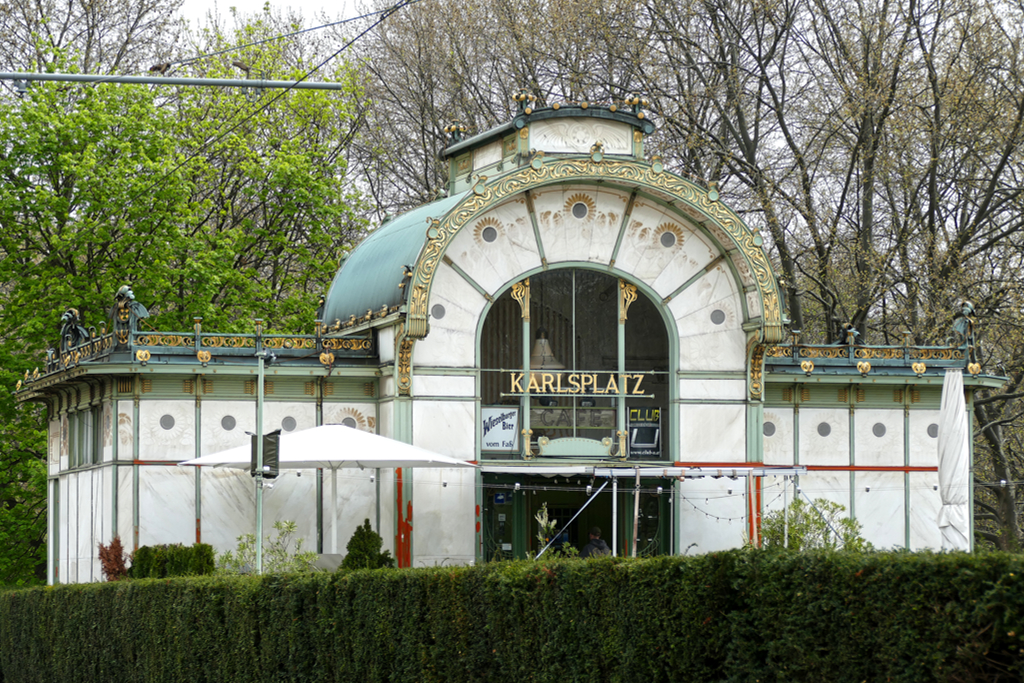
A park on the south side of the square occupies the largest part of the Karlsplatz. On its north side is the former Karlsplatz station, built by Otto Wagner in Art Nouveau style. Today it houses a café. You will often come across both, the architect Otto Wagner as well as cafés in this post as Vienna wouldn’t be Vienna without them.
To the east, not far from the Karlskirche, is the Vienna Museum and opposite the contemporary branch of the Albertina Galleries as well as a number of Wilhelminian-style townhouses.
Albertina Modern
The Albertina Modern is located in the so-called Künstlerhaus. The building was completed in 1868 and has served as an exhibition venue ever since. In 2020, it opened in a restored and expanded form as what is now the Albertina Modern. Modern, postmodern, and contemporary art is on display. The museum brings together the most influential Austrian artists with important international artists from the 20th century to the present in temporary exhibitions.
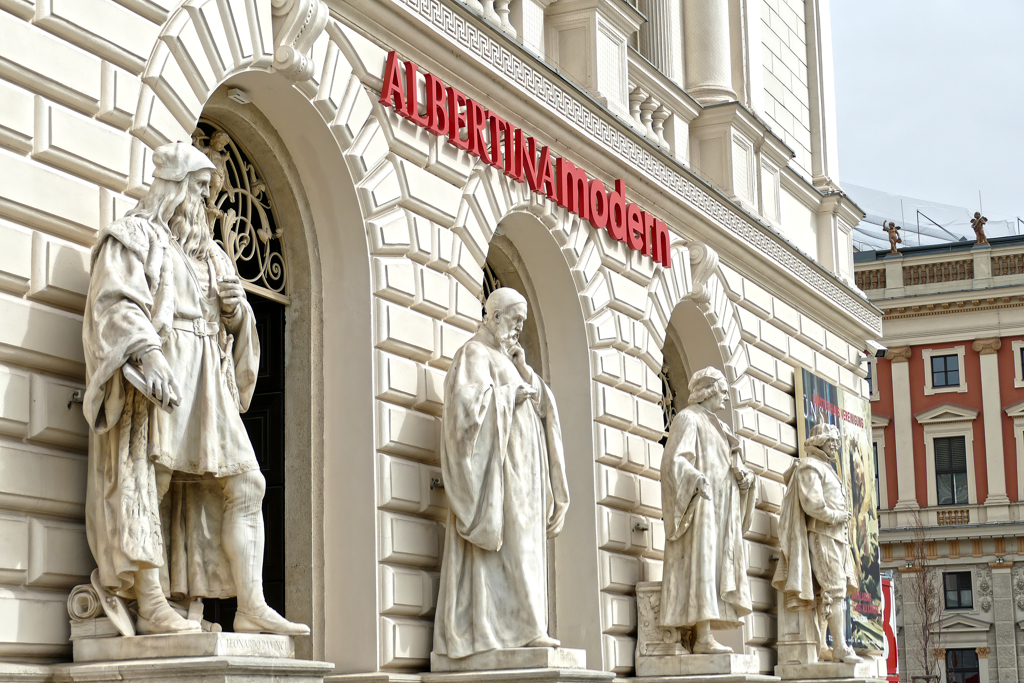
For a general entrance fee of 16 €uro, you can visit the galleries every day between 10 a.m. and 6 p.m. The Albertina consists of three buildings in different locations. If you want to visit at least two of them, you might want to get a combined ticket for 24.90 €uros. The three locations can be visited on different days within one year beginning on the date of purchase.
However, especially during public holidays and the high season, buying your ticket online is highly recommended.
Secession
The Secession is not only one of the most alluring buildings at the Karlsplatz but in all of Vienna. Joseph Maria Olbrich completed it in 1898 as an exhibition venue for contemporary art. The building is a very clever reference to the Karlskirche, particularly with its gold-colored dome. It is an amazing globe of foliage made of gilded wrought iron and was designed by Eduard Pötzl.

The Vienna Secession was a merger of visual artists from the fin de siècle period. Following the model of the Munich Secession, it was founded by Gustav Klimt, Koloman Moser, Josef Hoffmann, Joseph Maria Olbrich, and other artists as a, yes, secession from the conservative and historicism-oriented Künstlerhaus.
To this day, it is a gallery for contemporary art, but let’s not kid ourselves: most people come here because of the eye-catching gold dome and Klimt’s Beethoven frieze.

Gustav Klimt originally created his fantastic Beethoven Frieze for a temporary exhibition at the Vienna Secession in 1902. Today, it is on permanent loan from the Belvedere and can be viewed in the basement.
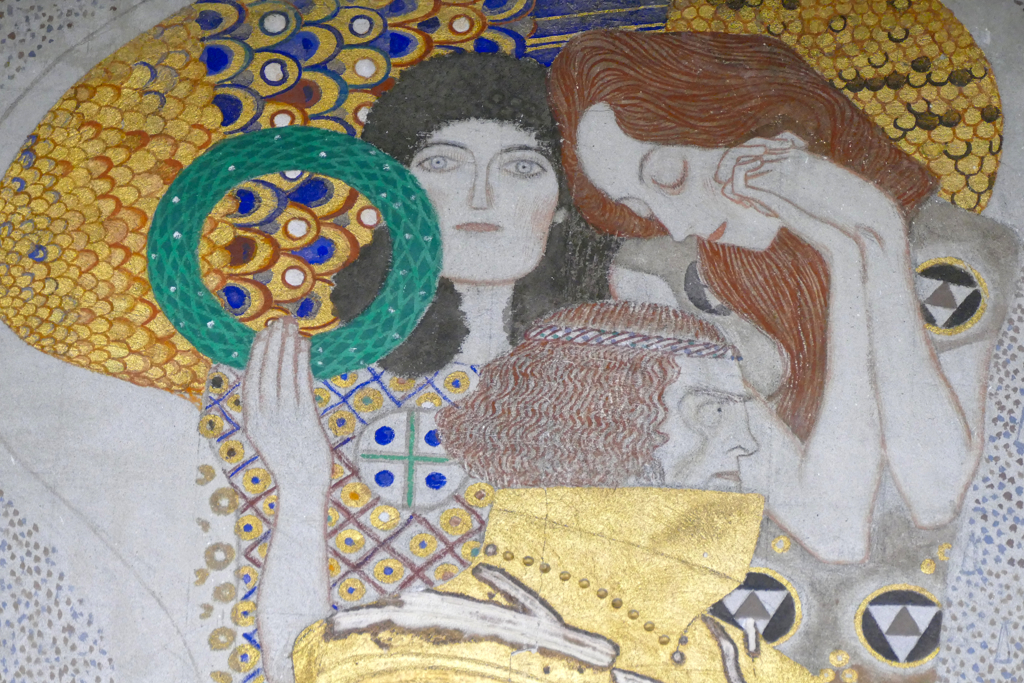
The Secession is open from Tuesday to Sunday between 10 a.m. and 6 p.m., and the general entrance fee is 12 €uros.
Fun Fact:
A depiction of the Secession building is on the back of the Austrian 50-cent coin – just in case you need a cheap keepsake.
Academy of Fine Arts
A bit hidden behind the Secession is the Academy of Fine Arts Vienna. As a matter of fact, it is one of the oldest art academies in Europe. The court chamber painter Peter Strudel founded the institution as a private academy in 1692.
For the average visitor, only the academy’s gallery will be of interest. It owns around 1,600 paintings from early Italian panels from the 14th and 15th centuries to paintings from the early 19th century. Apart from works by Lucas Cranach, Rembrandt van Rijn, Peter Paul Rubens, Titian, and Bartolomé Esteban Murillo, these include also Botticelli’s tondo Madonna with Child and Angels and Hieronymus Bosch’s Last Judgement Triptych.
Despite these fantastic masterpieces, comparatively few tourists visit the academy’s galleries. This makes visiting this cultural insider tip a quiet and relaxed experience for us art enthusiasts.
The gallery is open to the public from Wednesday to Monday between 10 a.m. and 6 p.m. The general entrance fee is 9 €uros.
Fun Fact:
Women were officially admitted to study at the academy for the first time in 1920. However, only in 1947, the first female professor was appointed at the academy.
Naschmarkt
While the academy is more of an insider tip, the Naschmarkt is an integral part of every tourist itinerary. On busy days, you can’t walk through the Naschmarkt, but have to let the crowds push you along squeezed between the stalls. If there’s one thing I really hate, it’s being pushed by large crowds. But a guide to Vienna wouldn’t be complete without the stupid Naschmarkt, so here it is.
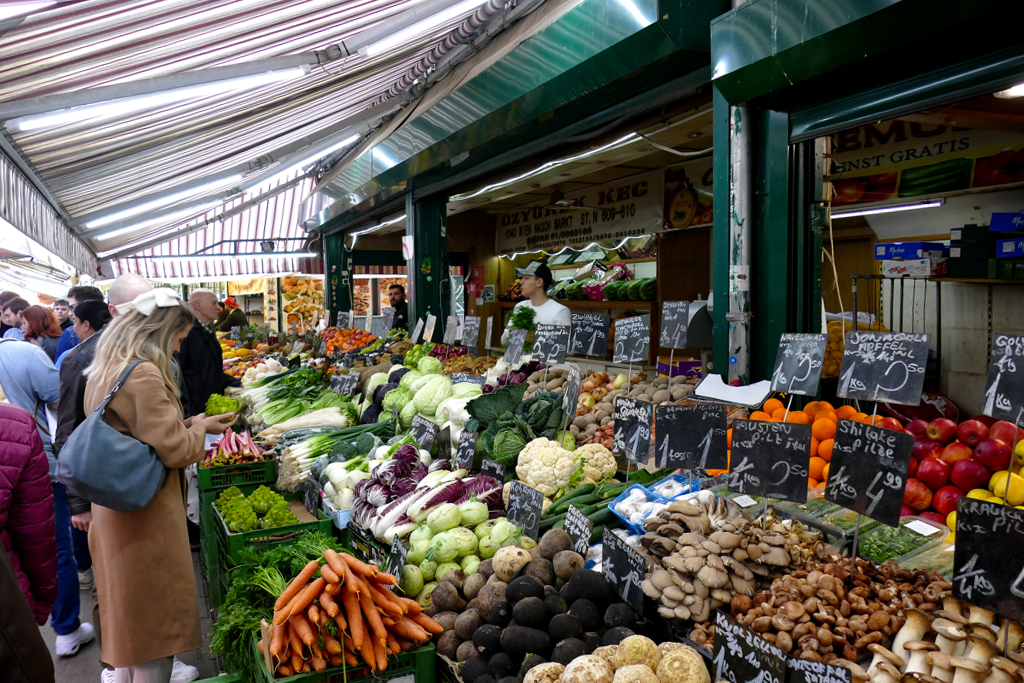
The Naschmarkt is the city’s largest inner-city market. While some vendors still sell fruit, vegetables, baked goods, fish, and meat, most of the stalls offer goods from Southeast Europe, the Middle East, and even East Asia. Most stalls are open from 6 a.m. to 7:30 p.m. on weekdays and until 6 p.m. on Saturdays.
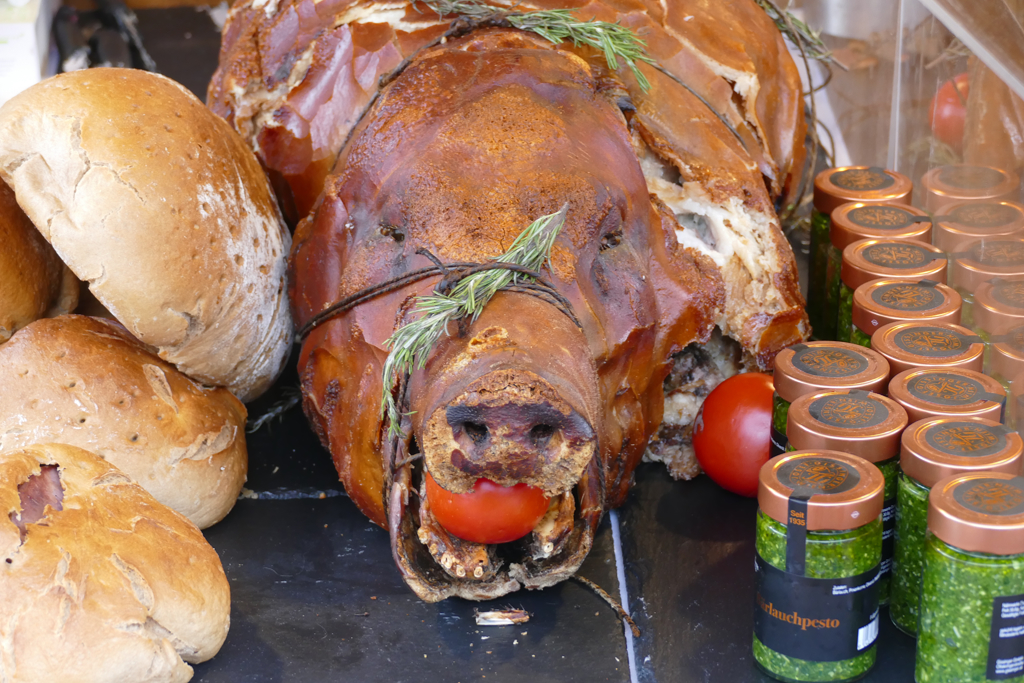
Since around 2000, many stalls have been converted into restaurants most of which stay open until 11 p.m. Therefore, the Naschmarkt is also busy in the evenings, especially during the summer months.
The Historic Center
So, that’s it for now south of the Ringstrasse. We cross and walk along the western side of the famous Vienna Opera into the old historic district. And no, we don’t buy tickets from the friendly young men dressed as some kind of Mozart.
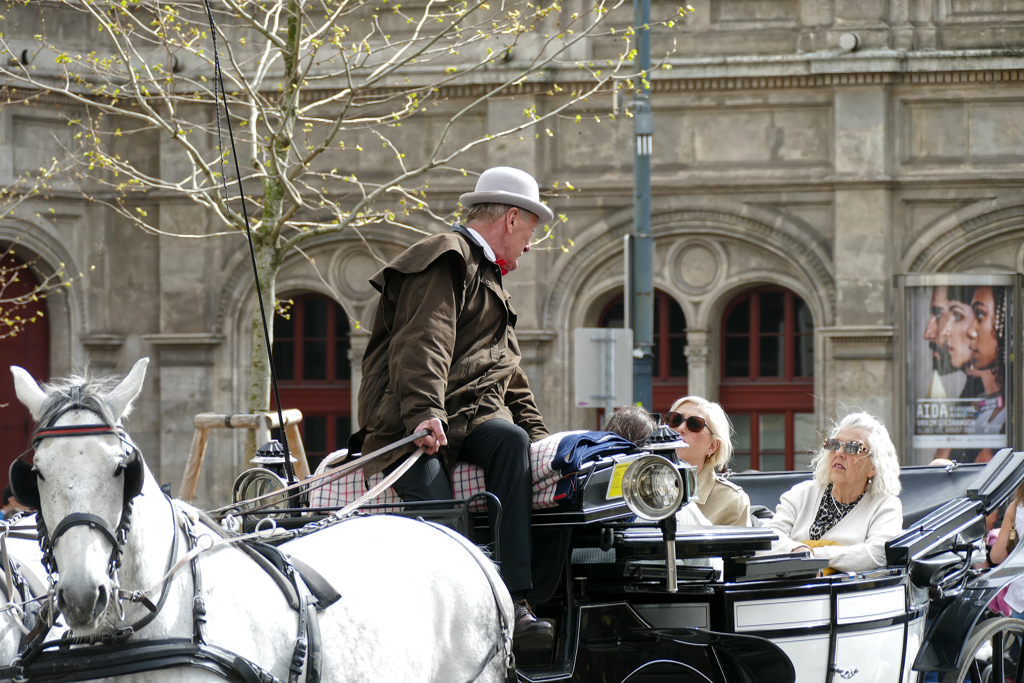
These tickets are a big scam: you can see a concert, but it will be some cheesy stuff in a back alley and definitely not worth what you pay for it.
Albertina
On the western side of the Albertinaplatz stands the eponymous Albertina Museum. It is housed in the Palais Erzherzog Albrecht, a historic residence of the Habsburg Emperors. The fact that the magnificent building is now called Albertina refers to Albert Casimir Duke of Saxony-Teschen. He was the son-in-law of Archduchess Maria Theresa and founded the museum collection in 1776.
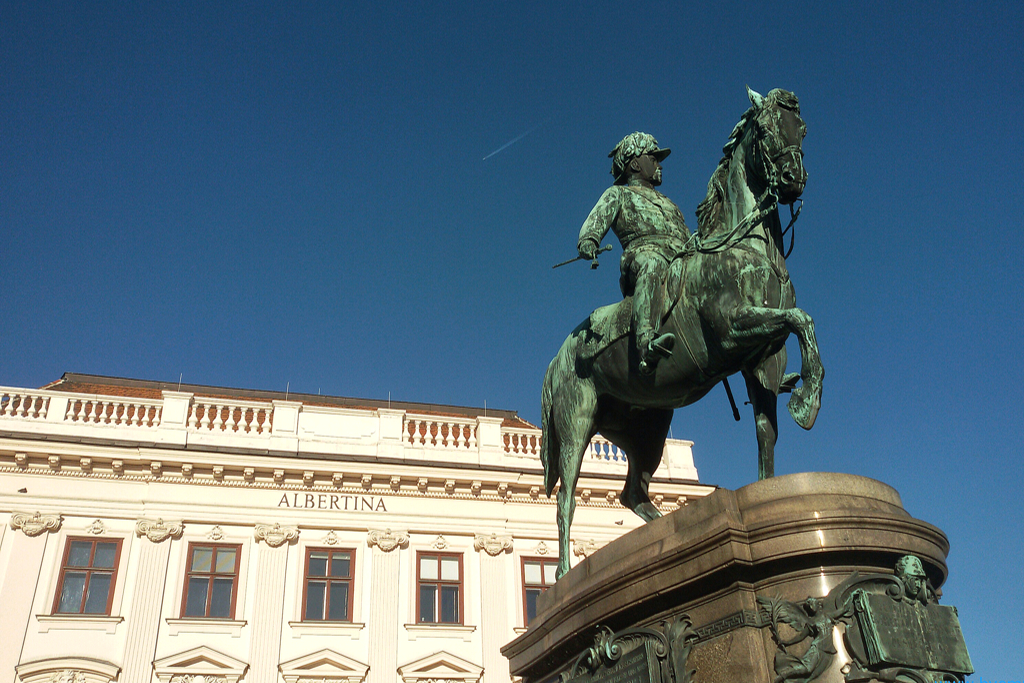
Although there is neither a Klimt nor a Schiele there, the Albertina is today one of the most visited museums in Vienna. Ever since the museum received a loan from the Batliner private collection in 2007, part of the exhibition space is no longer used to present the museum’s own collection, but rather a permanent show on classical modernism called Monet to Picasso. The Batliner Collection. It is a collection of art from the 19th and 20th centuries such as French impressionists and Fauves, German expressionists, and much more.
However, in the basement, they show changing temporary exhibitions. Also, you can visit the palace’s state apartments with the original furnishing on the first floor.
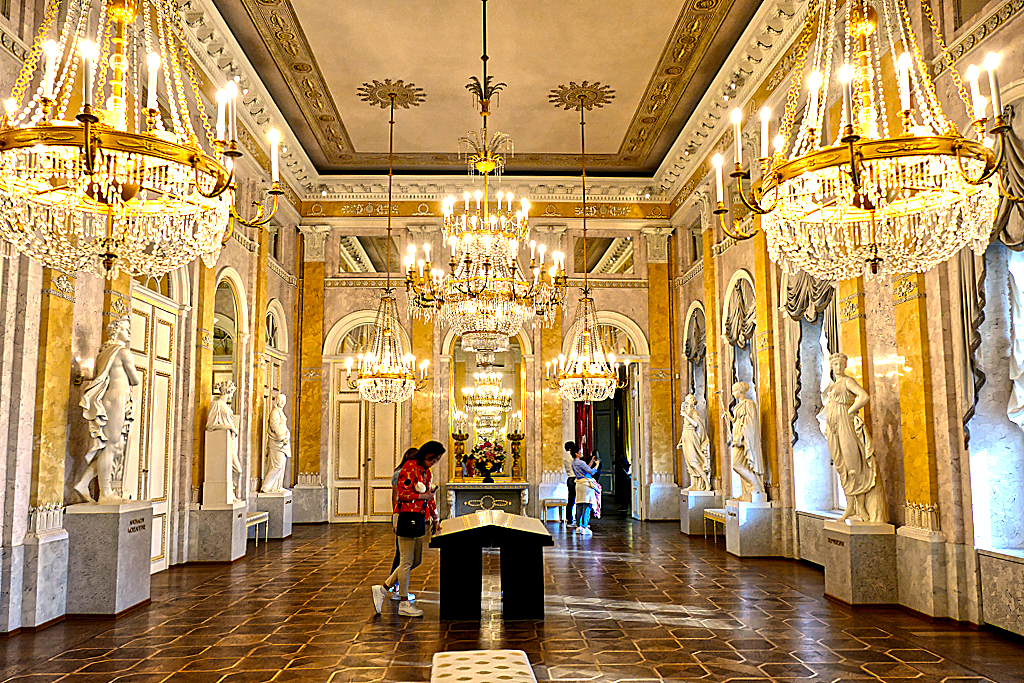
For a general entrance fee of 19.90 €uro, you can visit the galleries every day between 10 a.m. and 6 p.m. On Wednesdays and Fridays, they close only at 9 p.m.
The Albertina consists of three buildings in different locations. If you want to visit at least two of them, you might want to get a combined ticket for 24.90 €uros. The three locations can be visited on different days within one year beginning on the date of purchase.
However, especially during public holidays and the high season, buying your ticket online is highly recommended.
Hotel Sacher
On the eastern side is Austria’s icon when it comes to luxurious lodging: Eduard Sacher, son of Franz Sacher who invented the Sachertorte, purchased the building which was modeled on a Renaissance palace. There, he opened the hotel in 1876. Sacher was one of the best addresses in the Vienna right from the start.
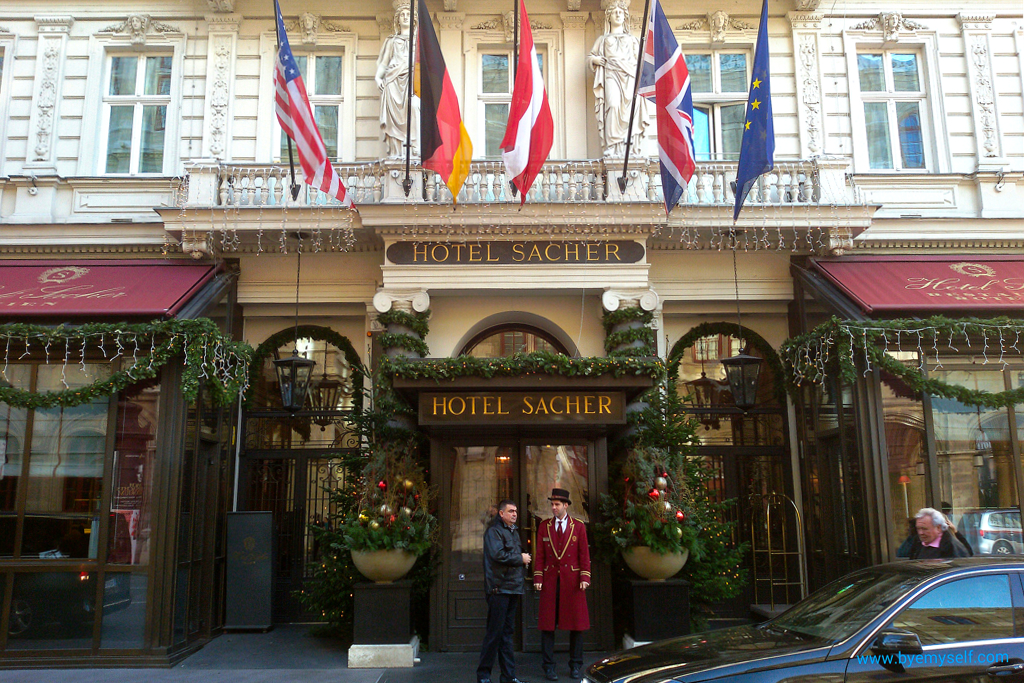
Royals and other celebrities such as Elizabeth II, John F. Kennedy, Leonard Bernstein, Kofi Annan, and many, many more rested their weary heads on the soft pillows of the Sacher.
As you pass by, you might see a very long line of people. They wait to get in to taste or buy one of the most famous Austrian specialties, the Sachertorte. This cake would probably be quite delicious if Franz Sacher hadn’t felt the urge to slap a gooey layer of apricot jam between the chocolate cake layers.
But who am I to judge? After all, the Sachertorte is not a cake, it’s an institution in itself. After a years-long legal dispute with the confectionery Demel, only the cake produced by Sacher is allowed to be labeled the Original Sachertorte. Nevertheless, it is imitated by many coffee houses, bakeries, and pastry shops; and to my chagrin, all of them ruin what could be a great treat by adding a gooey layer of apricot jam.
Fun Fact
After Eduard Sacher passed in 1892, his widow Anna ran the show. By the standards of the time, this lady was very emancipated. She smoked cigars, ran the business with rigor, and installed a company health insurance fund for her employees.
Yap, you’re right, the tour is advertised to take place by tram. Now you have already explored the entire Karlsplatz area on foot, and you could actually continue walking through the historic center.
If you don’t want to do that, you can get on tram #1 or alternatively on #2, #71, and D at the stop Oper/Karlsplatz. Then, get off at the next stop Burgring to visit the Hofburg.
See you there.
Everyone else now follows me to Neuer Markt Square.
Kapuzinergruft
As you make your way southwards toward the center of the historic district, you’ll get to the square Neuer Markt. It is one of the oldest squares in Vienna. The so-called Donnerbrunnen fountain stands in the middle and is surrounded by magnificent townhouses.
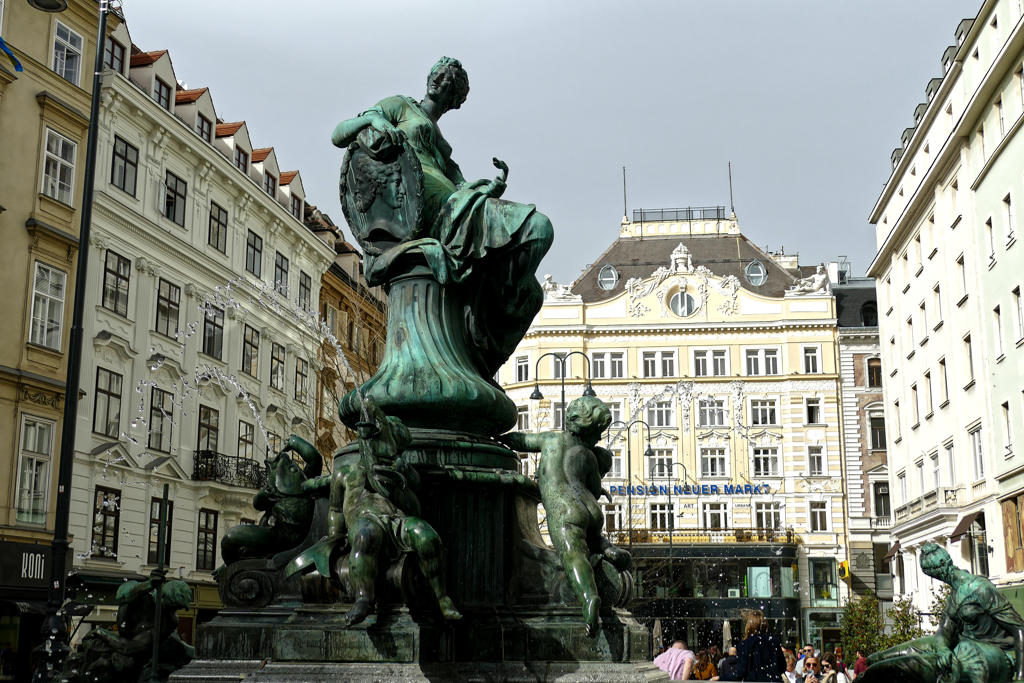
Georg Raphael Donner designed the Providentia Fountain in 1739. However, it is far better known under its creator’s name. The bronze sculptures are copies as the originals are in the Belvedere.
The most famous building around the square is the Capuchin Church which was completed in 1632. In its vast basement is the Imperial Crypt. Empress Anna commissioned the Capuchin monastery in her will and ordered the construction of the crypt in 1617. A year later she died. Construction began only in 1622. Today, the crypt is the final resting place for twelve Emperors, 19 Empresses, as well as many other members of the Habsburg and Habsburg-Lorraine families. In the so-called Franz Joseph’s crypt are the tombs of Empress Elisabeth aka Sisi and her hubby, Emperor Franz Joseph I, as well as their son, Crown Prince Rudolf.
In case of an exception, also non-members of the Habsburgs were buried here. A total of 147 corpses and four heart urns are in the crypt.
The last one to join was Yolande von Habsburg, wife of Carl Ludwig Habsburg-Lorraine, in 2023.
The Imperial Crypt is open every day from 10 a.m. to 6 p.m. and the general entrance fee is 8.50 €uros.
Fun Fact
Until 1940, the body of Napoleon Franz Bonaparte, Napoleon’s only son with his second wife Archduchess Marie-Louise rested in the Imperial Crypt. It was on Hitler’s order that he was transferred to the Hôtel des Invalides in Paris in 1940. So much to Rest In Peace.
Saint Stephen’s Cathedral
From the Neuer Markt, it’s just five minutes to Vienna’s official icon, the Stephansdom. Constructed the early 12th century, Saint Stephen’s Cathedral towers over the square Stephansplatz as one of the most important Gothic buildings in all of Austria. It is the Roman Catholic Archdiocese of Vienna and also the seat of Vienna’s Archbishop.
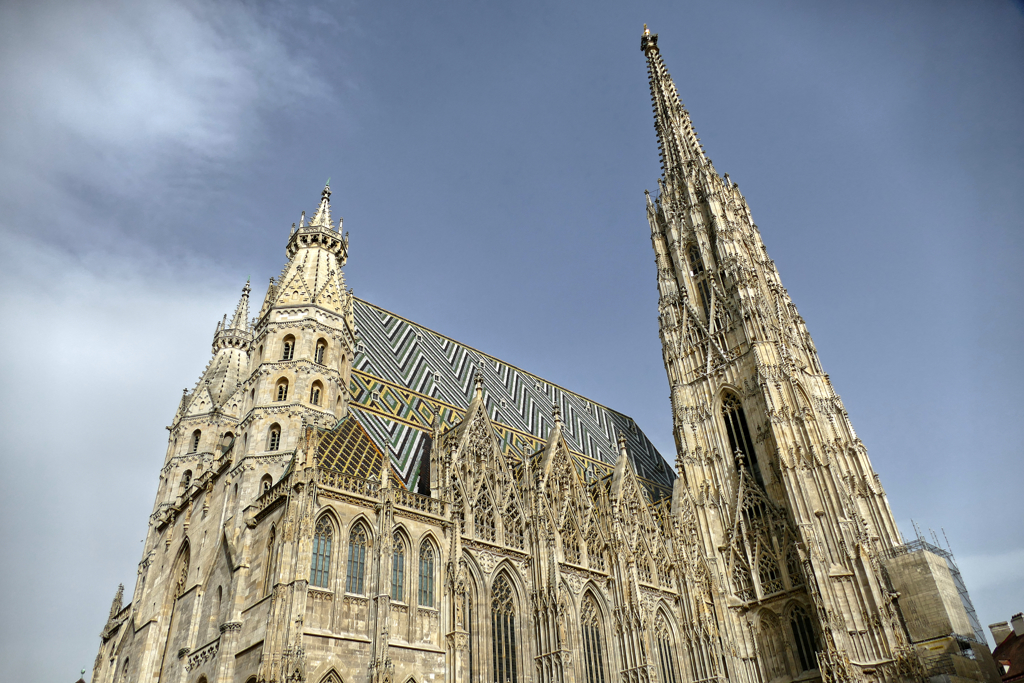
The most striking feature apart from the towers is the roof. Over a length of 110 meters, it is covered with around 250,000 tiles. In a total of ten colors, they are immaculately arranged in a zigzag pattern in the nave area. Each of these bricks weighs 2.5 kg, is nailed to the rafters with two copper nails, and is also embedded in mortar.
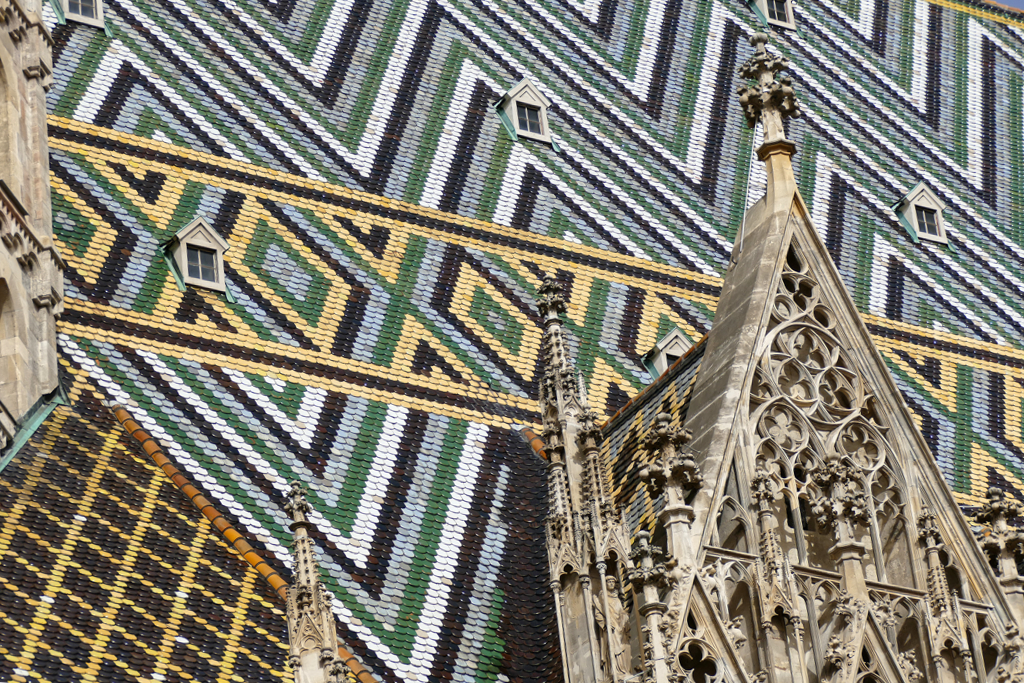
Inside, you get to see precious altars and chapels. However, there are also the treasury and the catacombs to be visited. To get to the tower chamber, you have to climb challenging 343 steps. Yet, once up there, you are rewarded with an incredible view of the entire city and beyond.
A general ticket to the cathedral sets you back 7 €uros. However, for a whopping 25 €uros, you can purchase a pass that includes an independent tour of the cathedral with a digital audio guide for your smartphone as well as a self-guided tour of the south and north towers. Furthermore, you can join a public catacomb tour and visit the cathedral museum. Also, a visit to the Treasury of the Teutonic Order is included.
The pass is valid for one year and can be purchased directly in the cathedral or online.
The cathedral opens daily from 6 a.m. to 10 p.m., and on Sundays only at 7 a.m.
Manner – a World-Famous Waffle
Stories and history, art and architecture, literature and music – there is so much in abundance in Vienna. Nevertheless, the sweetest specialty this city of plenty offers is…sweets.
Josef Manner ran a small shop selling chocolate and fig coffee. In 1890, he founded the Josef Manner Chocolate Factory together with his brothers. Their iconic waffle called Mannerschnitte, however, was invented only in 1898. By 1913, Manner had become the leading confectionery producer in Austria-Hungary. Today, Manner aficionados can do their candy shopping at the flagship store on Stephansplatz in the Archbishop’s Palace.
As you step into the narrow little shop, you feel like you’re entering a world made of chocolate and cookies. The shelves packed with delicacies dictate the direction in which customers advance as they fill their shopping baskets. There is no way back, the aisles are far too narrow to walk in the opposite direction.
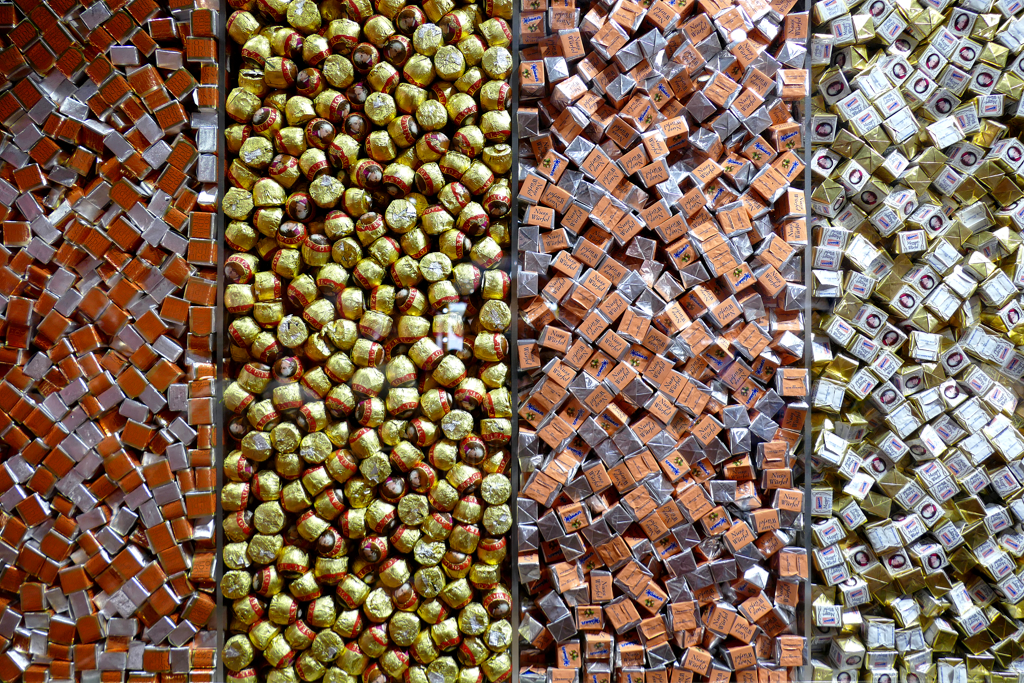
Even though the fine Mannerschnitte remains the most famous and popular product, it has long since been supplemented by other delicacies such as Mozartkugeln and nougat cubes.
Yet, the Mannerschnitte is Queen. Four layers of filling made from sugar, hazelnuts, coconut oil, and cocoa powder are spread between five layers of waffle. With a bite-sized measure of 49 × 17 × 17 millimeters, the total weight of a waffle is a fluffy 7.5 grams. This format as well as the recipe have never been changed.
However, Manner’s marketing people are not resting and have expanded the range to a number of non-edible items in the typical Manner pink such as bags and boxes, pens and lighters, golf balls and tracksuits, and much more.
Manner’s land of milk and honey chocolate and waffles is open daily from 10 a.m. to 9 p.m.
Fun Fact
Since 1889, Manner has used a depiction of St. Stephen’s Cathedral designed by Josef Diltsch as their trademark. In return, the company has been covering the labor costs for a stonemason in the cathedral building for several decades now. However, the good man is sporting workwear in the iconic Manner pink.
Graben
However, the Manner company is not the only business that has entered into a fruitful cooperation with a traditional Viennese institution. In 2005, the global clothing chain from Sweden Hennes & Mauritz moved into the former store E. Braun & Co. In this way, not only the tradition of selling clothes was continued. H&M even took over the historic interior. A ride in the old elevator is a particularly special experience. The store is open weekdays from 10 a.m. to 8:00 p.m., on Saturdays, they already close at 6 p.m.
H&M is one of the many globally operating store chains located alongside the square Graben. spreads from Stephansplatz all the way to the Kohlmarkt. Narrow historic streets branch off from the Graben, which was designed as a pedestrian area. The development on the north side is still irregular and there is only a single narrow passage to St. Peter’s Church.
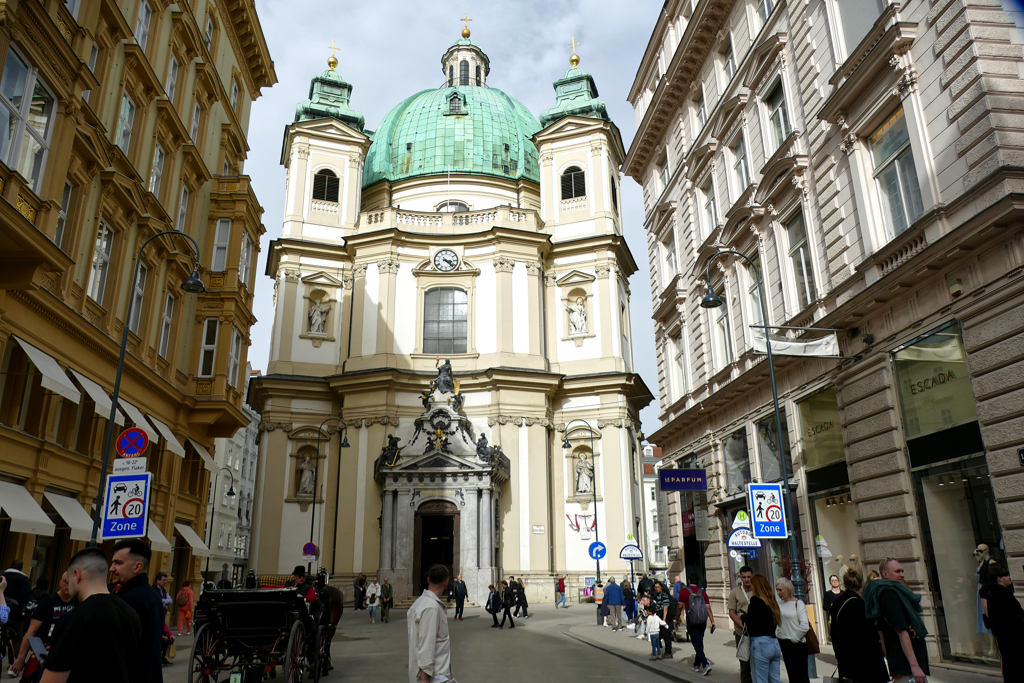
Graben translates to moat, and that’s what there was in ye olden days. At the turn of the 14th century, the moat was overbuilt. Mainly wooden houses were constructed. In 1327, a fire broke out which destroyed the entire area.
From the Ashes
In the course of the 18th century, the market between the rebuilt houses was reduced. This way, the Graben became the central site of urban life and a preferred zone for promenades. To this day, the square is Vienna’s most important place for leisure and shopping. Locals and visitors sit side by side on the restaurant terraces in the middle of this pedestrian street to enjoy refreshments and watch people.
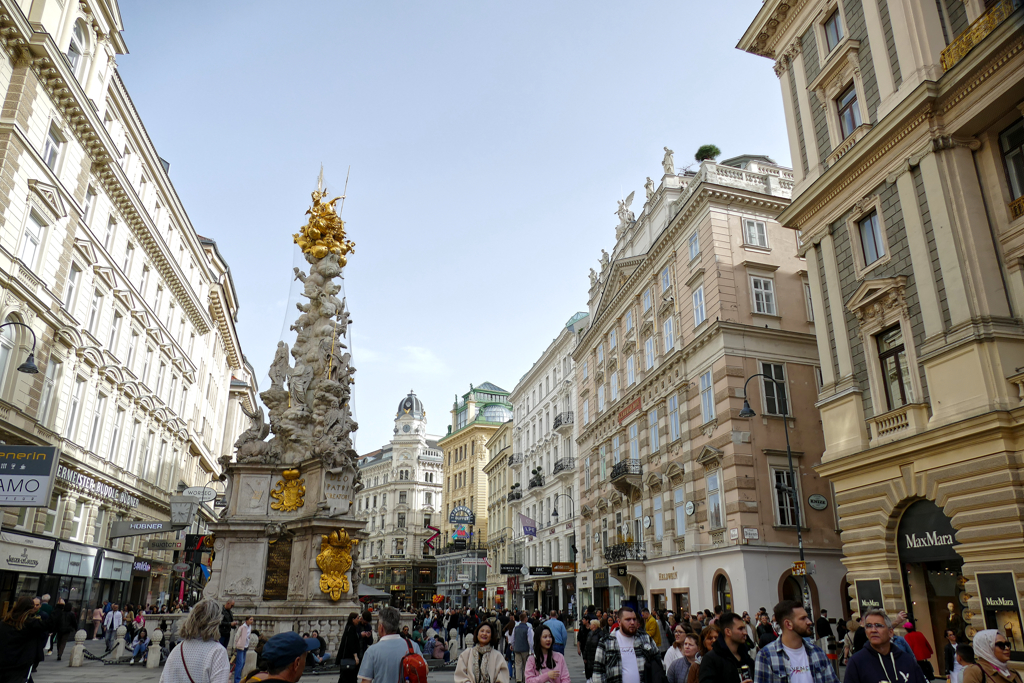
The most striking feature of the moat is the so-called plague column. In the aftermath of the plague epidemic in 1679, Emperor Leopold I vowed to erect a column of grace honoring the Holy Trinity. The plague column was completed in 1692.
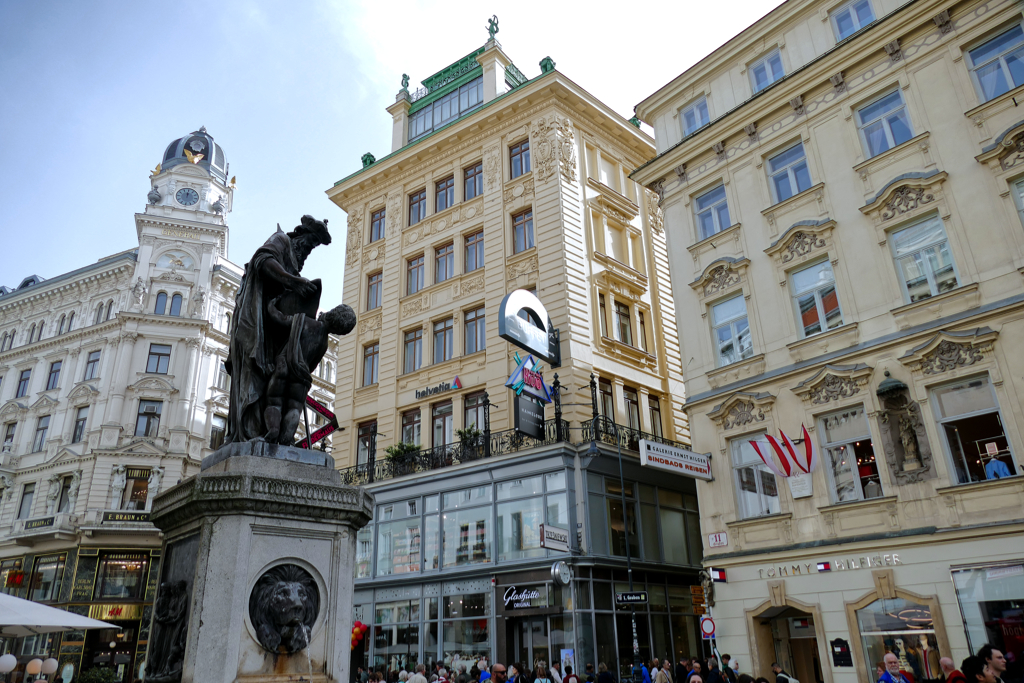
In addition to the column, there are also two wells in the Graben. They were built in the mid-15th century. The water was then piped from the Hofburg Gardens into the fountains. One of the stone fountains is adorned with a statue of Saint Florian. The statue explains the fountain’s most important purpose: Fighting fires.
Julius Meinl
There is still a striking number of food companies active in Vienna that were founded in the last centuries. In addition to Mr. Sacher and Mr. Manner, whom I have already introduced above, one of them is Julius Meinl. In 1862, Meinl founded a spice shop that initially only offered green coffee beans, but later also freshly roasted coffee.
The product range was gradually expanded and included other self-produced goods such as tea, chocolate, cocoa, biscuits, and jams. Eventually, all kinds of canned goods were added. This way, the company developed into the first vertically integrated food group in Austria.
Today, the flagship store Meinl am Graben is mostly frequented by tourists. Products such as tea, coffee, jam, confectionery, wine, and spirits are sold. In addition to a selection of fresh foods, various house-made staples are also marketed. However, the core activity is still the production and trading of coffee.
In front of the store is a nice terrace, and the restaurant on the first floor was awarded three toques by Gault-Millau.
Changes
I would also like to mention the company’s social policy. A family-friendly free Sunday was introduced as early as 1907. I know, Americans are now cursing because they have to miss out on an extensive shopping trip one day.
The introduction of a 5-day week with 43 weekly hours followed in 1931.
Special apprenticeship was introduced as early as 1906: Meinl’s salespeople were trained in handling products and, of course, getting polished manners.
That’s all great and I love strolling through the store. However, you cannot deny that the prices are completely exorbitant. I’m not talking about special artisan creations, but about foods that you can get at any supermarket for about a third cheaper. Yet, I recommend checking out the coffees and accessories, which also make excellent souvenirs. And people-watching while enjoying a refreshment on Meinl’s terrace is a great activity – or do you call it rather a passivity in this case?
Either way, Meinl is open on weekdays from 8 a.m. until 7.30 p.m. and Saturdays from 9 a.m. until 6 p.m. It’s closed on Sundays, as I already announced above.
Kohlmarkt
Meinl also gets away with its ridiculous prices since it’s on the corner of Kohlmarkt. Kohlmarkt is a small shopping street, but it easily makes up for it with a dizzying density of jewelers and branches of international luxury labels. This is also ironic because Kohlmarkt is translated to cabbage market.
One of the exclusive shops is the former purveyor to the court Demel. Demel is, how could it be otherwise in Vienna, another pastry shop. There are also long queues in front of this store. Yes, plural: queues. The crowds are so big that there has to be a line for customers and one for guests of the café.
Hopefully, both of them have fed their piggy banks generously beforehand, because Demel’s prices are completely exorbitant.
However, if you’re willing to pay 18 €uros for 70 grams of flower-shaped chocolate in a colorful cardboard box, you’ll be rewarded by shopping in an interior in the neo-rococo style made of the finest mahogany wood and lots of ornate mirrors. In addition, ladies in black attires with white aprons will serve you. They are called Demelinen and traditionally address the guest in a special Demel-German, a la-di-da in the third person plural. Yet, if you don’t speak German, you won’t even notice this perk.
Hofburg
Demel is just a few steps from the Michaelerplatz, a square east of the Hofburg.
The Hofburg was the Harburgs’ Viennese residence from the 13th century until 1918. With 24 hectares, it is the largest building complex in Europe for non-religious purposes. It consists of many large tracts including two church buildings.
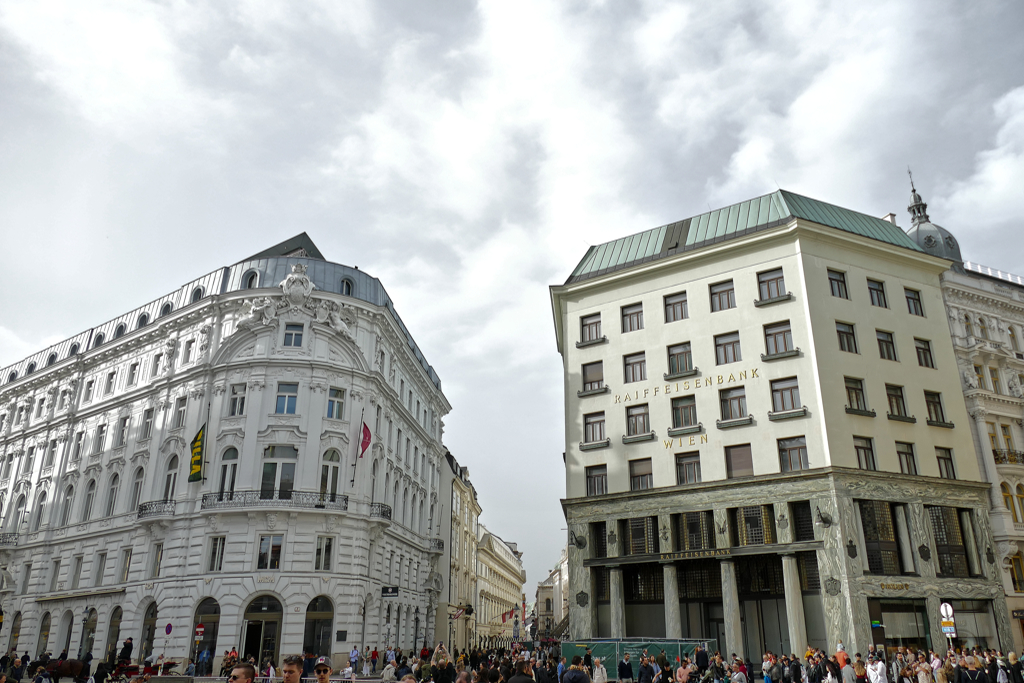
The castle garden adjoins the southeastern front. In contrast to the so-called Volksgarten, only members of the imperial family were allowed to use it. The castle garden was only opened to the general public in the 1920s.
Since 1946, the Hofburg has been the official residence of the Austrian Federal President. It also houses most of the Austrian National Library as well as various museums.
Sisi Museum and the Silver Collection
Coming from the Michaelerplatz, you are entering the complex through the Michaeler Gate. This gate is the entrance to the splendid Michaelertrakt, hence, St. Michael’s wing of the Hofburg. The round hall under the magnificent dome is absolutely remarkable.
And it also houses the entrance to the Sisi Museum.
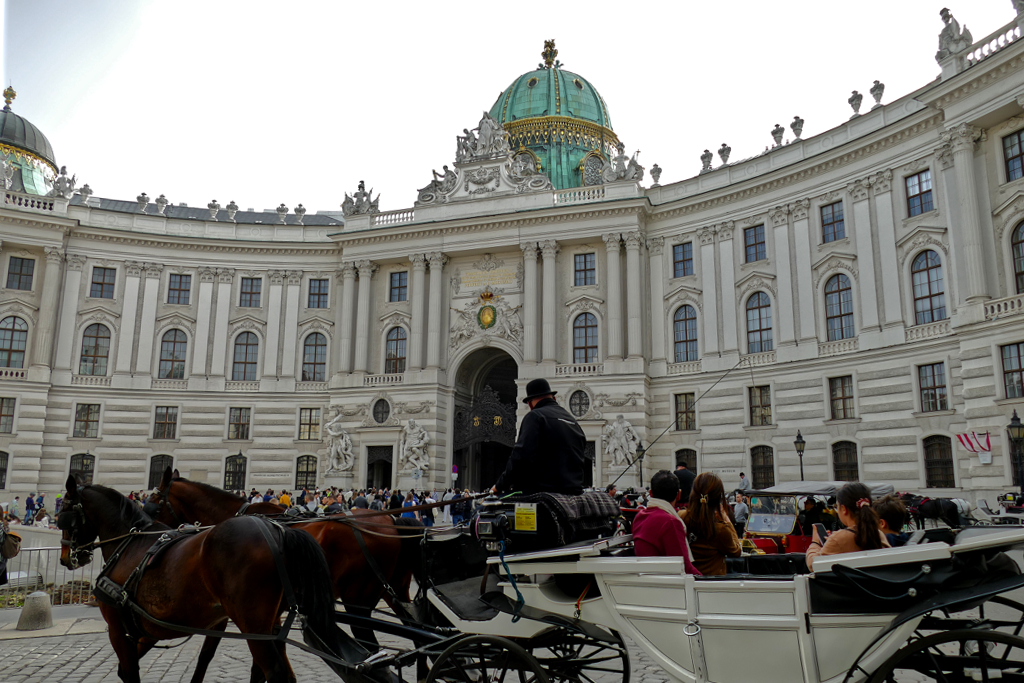
The Imperial Apartments, the Sisi Museum, and the Silver Collection are among the most visited venues, obviously. My image of the Empress Elisabeth of Austria aka Sisi is without doubt influenced by Ernst Marischka’s cheesy trilogy of Sisi movies that I have to endure Christmas after Christmas after Christmas. Therefore, I was rolling my eyes when getting to the museum, but I must say, it’s really very nice and interesting and not at all tacky. It explains all the difficulties Sisi undoubtedly had with her role and herself: her obsession with sports, her anorexia, her longing, and her fears.
However, I particularly enjoyed the exhibition of costumes and attire from the former annexed regions of Bohemia, the Balkans, and Italy. Until 1918, they all were part of the imperial and royal Austria.
Welcome to the Habsburgs’ Crib
In a different wing, the originally furnished and decorated Imperial Apartments can be visited. At the former Silver Chamber, you get to see the Habsburgs’ precious porcelain, glass, and silverware.
The Sisi Museum and the Silver Collection are open every day from 9 a.m. to 5.30 p.m. for an entrance fee of 19.50 €uros. If you are planning on visiting also the Schönbrunn Palace, you can save by buying the so-called Sisi-Ticket that includes those two venues as well as the Vienna Furniture Museum for 58 €uros. It is valid for one year from the date of issue, and you do not have to book a time slot.
Hundred Museums
There’s a reason Vienna enjoys the reputation of being one of the most culturally rich cities in the world. But Vienna’s museums don’t just contain collections of classical, modern, and contemporary art, culture, and science. Among Vienna’s more than 100 museums, there are also quirky exhibitions on topics such as the history of the funeral industry. On the other hand, there is the slightly more cheerful circus & clown museum. You can visit a museum dealing with the history of heating technology, and if you’re rather interested in leisure, the Men’s Singing Association Museum might do. Not only will you find the Museum of History of Criminal Investigation and Critical Viennese Crimes. No, the Counterfeit Museum deals specifically with the history of forgers and forgeries.
Well, in this part of my guide, I’ll limit myself to the classics, hence, galleries where you can simply enjoy beautiful art.
No matter whether you took the tram or if you crossed the historic center by walking with me, we will meet at the Burgring stop. To the west lies the magnificent square called Maria-Theresien-Platz. In the mid-19th century, ambitious plans foresaw the building of an Imperial Forum in the vicinity of the imperial residence.
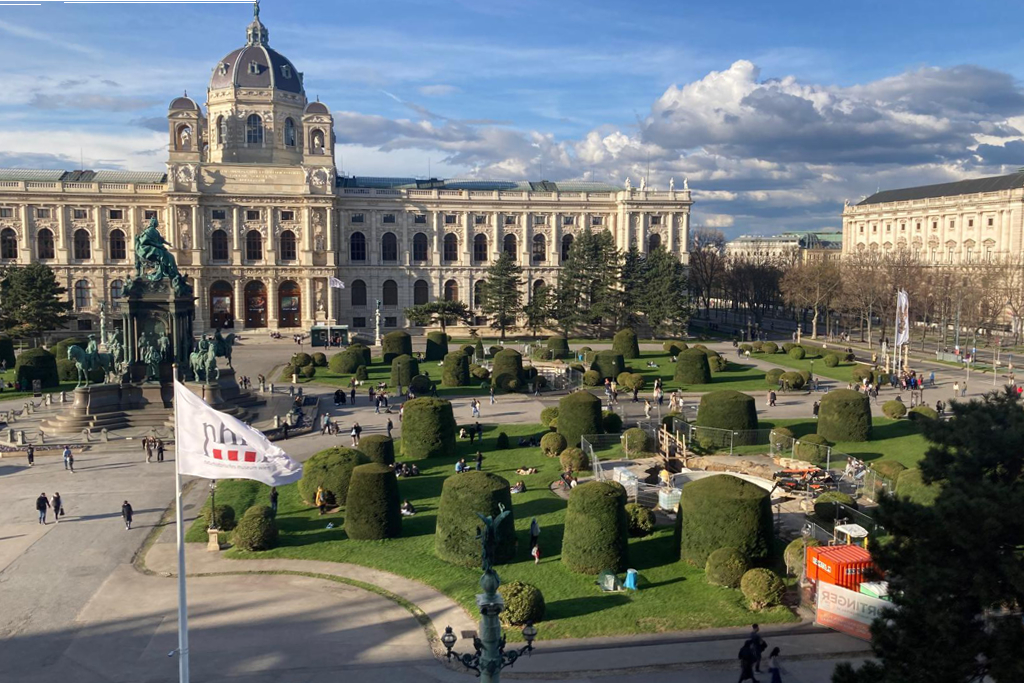
This project was only partially realized. The Natural History Museum on the northern side was opened in 1889. The Art History Museum then followed in 1891. Between them stands surrounded by four lawns a massive Maria Theresa Monument as well as the Triton and Naiad fountains.
Museum of Art History
The Museum of Art History was created from the Habsburg collections, especially from the portrait and armor collection of Ferdinand of Tyrol, the collection of Emperor Rudolf II, as well as the painting collection of Archduke Leopold Wilhelm. Consequently, it houses incredible treasures from all epochs and from around the world. Whether the Cranachs, Raffael, and Tizian, whether Velazquez or Caravaggio as well as the masterpieces by the Bruegels: These galleries have them all. And this is only the painting section. It takes certainly many hours if you really want to see everything.
However, if you have only a little time and are not the greatest art aficionado, this museum could be skipped since it does not reflect Austria and namely, Vienna as much as the other art museums do.
The Museum of Art History is open from Tuesday to Sunday between 10 a.m. and 6 p.m. On Thursdays, they are closing only at 9 p.m. The general entrance fee is 21 €uros. In case you don’t have any pass that grants you a discount, you might consider buying a so-called Masterticket that covers the Museum of Art History and the Museum Ludwig for 32 €uros. Alternatively, there is the so-called Habsburg Treasures ticket that includes the Museum of Art History as well as the Imperial Treasury Vienna. This pass costs 29 €uros.
Museum of Natural History
Around 1750, Empress Maria Theresa’s husband Franz I Stephan of Lorraine acquired the largest collection of natural objects at the time. The heart of the collection was 30,000 objects, including rare snails, corals, and shells as well as precious gemstones and rare minerals. Amazingly, the collection was already sorted according to scientific criteria.
As over the years, the collections became too large to be stored in the palace, it was moved to the Museum of Natural History. Today, the museum owns an incredible 30 Million pieces. Obviously, it is one of the most important Natural History Museums in the world.
In case you are travelling with kids or if you are really a sucker for nature studies, a visit might be a great idea. Otherwise – especially if you’re on a tighter schedule – I’d rather skip it since it has next to nothing that might be considered Vienna-related.
The Museum of Natural History is open from Tuesday to Sunday between 9 a.m. and 6 p.m. On Wednesdays, they are closing only at 8 p.m. The general entrance fee is 18 €uros.
MuseumsQuartier
The so-called MuseumsQuartier is located right behind the Maria-Theresien-Platz. The buildings were constructed as imperial court stables in 1725. Later, they were converted into the Trade Fair Palace in 1922. Throughout 2001, the venues of the MuseumsQuartier opened their doors to the art aficionados. The original baroque buildings remained in place and are now juxtaposed with the modern architecture of the new museum structures, obviously.
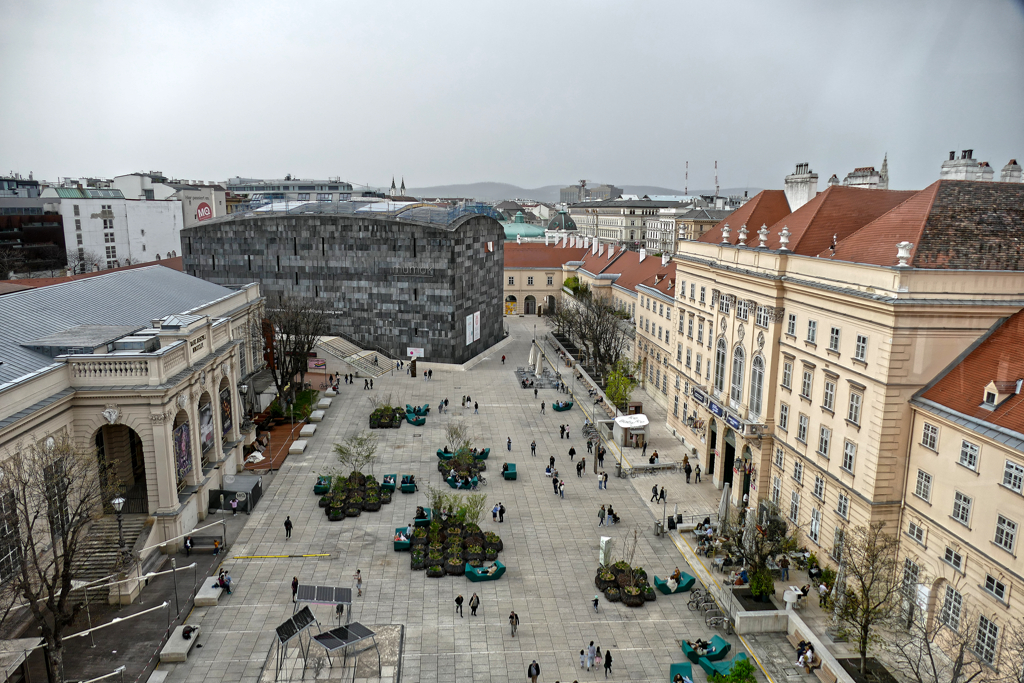
On an area of around 90,000 square meters are nine large cultural institutions. Despite its name, the MuseumsQuartier does not only house art galleries. It offers a wide range of fine art and architecture, dance, performing arts, concerts, and more.
The courtyards of the MuseumsQuartier are a wonderful spot for taking a break even if you don’t visit any of the galleries. During the summer months, the patio is filled with multifunctional furniture and becomes a very pleasant recreational area. You can get refreshments and treats from the café as well as various pop-up snack stands.
Leopold Museum
Although you are welcome to just hang out in the MuseumsQuartier’s courtyard, most visitors come here to partake in one of the events or to visit at least one of the exhibitions.

The most famous venue is certainly the Leopold Museum. It opened in 2001 and shows the collection of the late Rudolf Leopold, a famous ophthalmologist and art collector, and his wife Elisabeth. They brought together the world’s largest collection of Egon Schiele’s expressionist drawings and paintings.
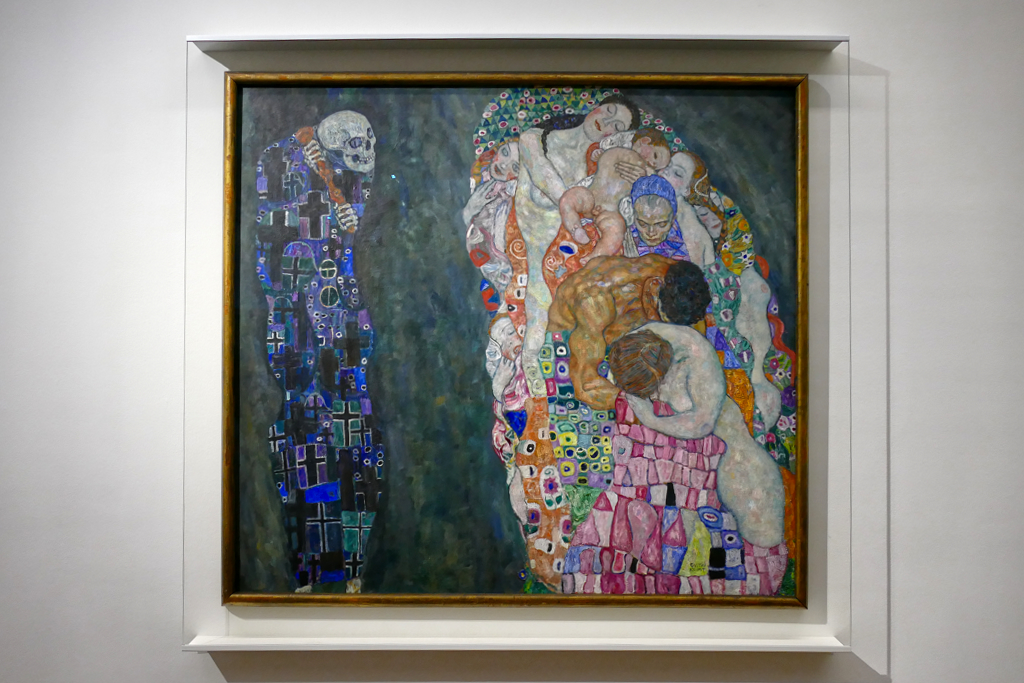
However, you also get to see paintings by Gustav Klimt, a pioneer of modern painting in Austria and one of the most outstanding members of the Secession. Obviously, there are paintings, drawings, and sculptures by many more artists of the 19th and 20th centuries.

The collection is completed with valuable handicrafts and original furniture from Art Nouveau and the Wiener Werkstätte.
The Museum of Natural History is open from Wednesday to Monday between 10 a.m. and 6 p.m. The general entrance fee is 17 €uros. In case you don’t have any pass that grants you a discount or even free access, you might consider buying a so-called Masterticket that covers also the Museum of Art History and costs 32 €uros.
MQ Libelle
In 2020 the MuseumsQuartier got a fantastic addition, the MQ Libelle. It is a spacious roof bar on top of the Leopold Museum and can be reached via two elevators on the outside of the galleries. Hence, you don’t need to visit the museum to get access. It is free for all.
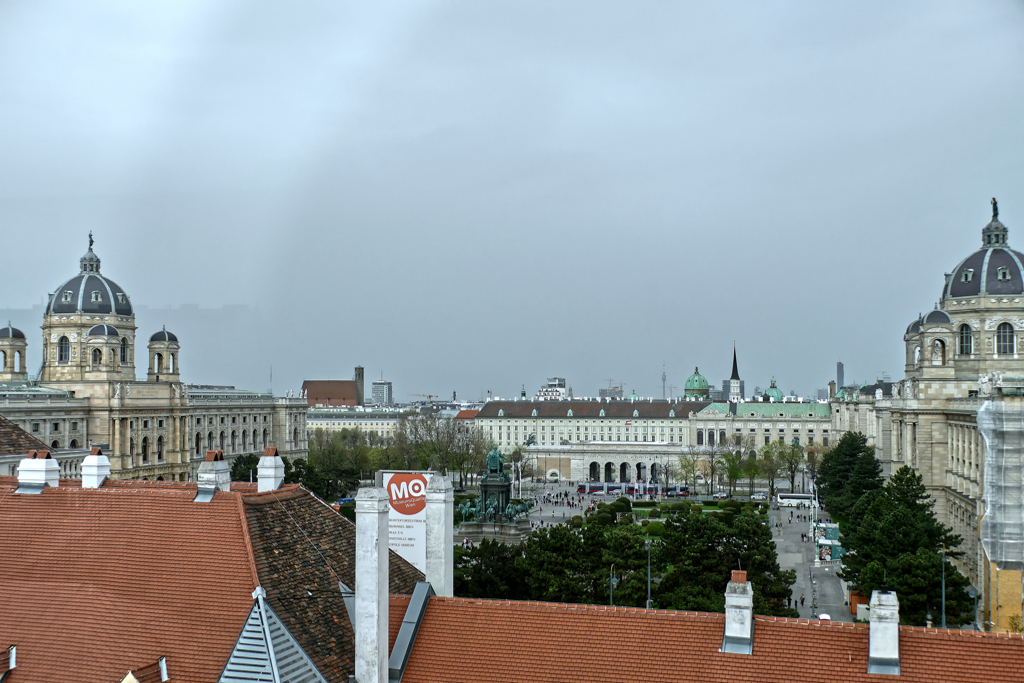
There is a snack bar with a small seating area and lots of space. Obviously, you have a fantastic view of the courtyard below and the beautiful surroundings.
The MQ Libelle is open from Wednesday to Monday between 10 a.m. and 10 p.m.
Grandiose Structures
As you get back on the tram at the stop Burgring, we’ve already seen so much and we’re only halfway around. However, the density of attractions and landmarks at the following stops is much lower. If you don’t want to take photos, you don’t even need to get off unless you need a moment to take the palace’s splendor in.
Don’t worry, the next tram is coming soon.
Parliament
The imposing building was completed in 1883 according to a design by Theophil von Hansen. The architect created his work following ancient Greek architecture in a neo-renaissance style. One of its most striking features, the Pallas Athene Fountain, was added only in 1902. Its main elements are a four-meter-high Pallas Athena which represents the legislative and executive power, as well as the four most important rivers of the former Austrian Empire, the Danube, Inn, Elbe, and Moldau.
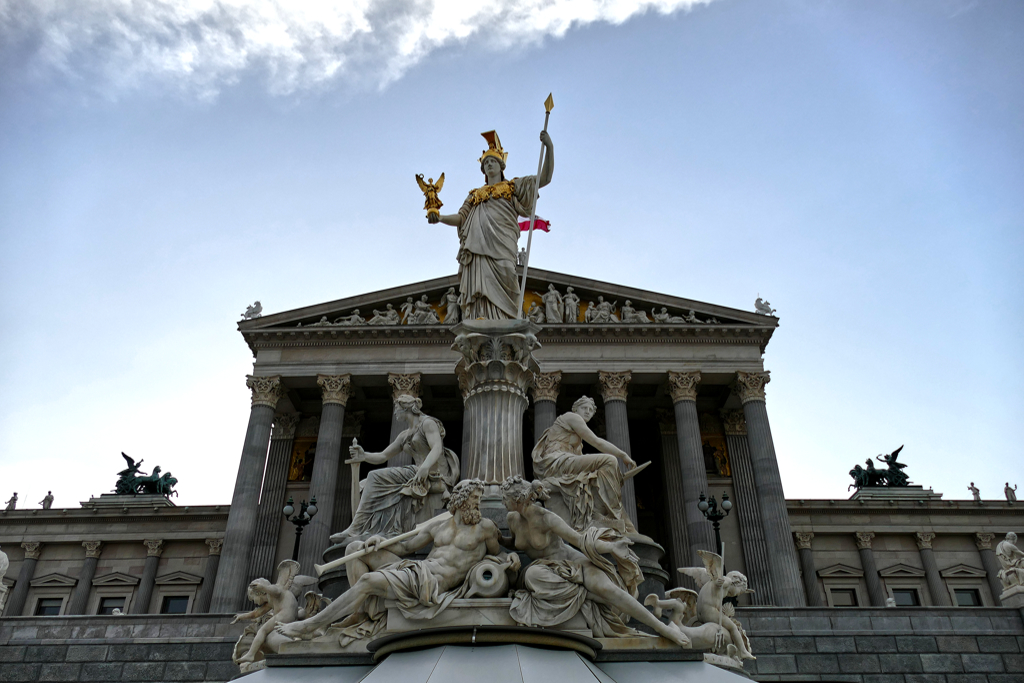
Obviously, the parliament is the central place of Austrian politics. It is the seat of the Austrian Parliament, the National Council, and the Federal Council. It contains three assembly rooms, representation chambers as well as office and conference rooms.
On a guided tour, you will experience how and where politicians work. The tours are free and are offered in different languages. They usually take about an hour, and appointments can be booked 28 days in advance. They are activated daily on this website.
Townhall
At the next stop called Rathaus, you’ll spot the so-called Burgtheater to your right. It is one of Europe’s most prestigious theaters. Every actor is proud to have been a Burgschauspieler, a Burg-actor.
To the left is Vienna’s town hall. It was completed in 1883 in the neo-Gothic style based on designs by the architect Friedrich von Schmidt. The exterior is inspired by the tradition of Flemish Gothic town halls like the one in Brussels. The floor plan with seven courtyards, on the other hand, follows the concept of baroque palaces.
Obviously, the town hall is the mayor’s seat and houses the municipal council, the state parliament, and other municipal entities. However, it can be visited on Mondays, Wednesdays, and Fridays at 1 p.m. The tour is free of charge, but there is a limit of 50 participants. So-called counting cards are issued on-site on the day of the tour between 8 a.m. and 10 a.m. Although the tour is in German, audio guides in English, French, Italian, Spanish, and Russian are available.
Austrian Postal Savings Bank
As the tram rattles on towards the Danube Canal, you’ll spot Vienna’s University complex is to your left right past the town hall. At the next stop called Börse, you’ll spot the stock exchange building to your right. The building, designed by Theophil von Hansen, the builder of Vienna’s parliament building, was completed in the Neo-Renaissance style in 1877.
The tram turns right and goes alongside the Danube to Schwedenplatz where we’ll switch trains.
On tram #2, we continue our tour to the stop Stubentor.
Here stands the Österreichische Postsparkasse, Austria’s Postal Savings Bank. It is one of the most famous Art Nouveau buildings in Vienna. The famous architect Otto Wagner designed it in 1904.
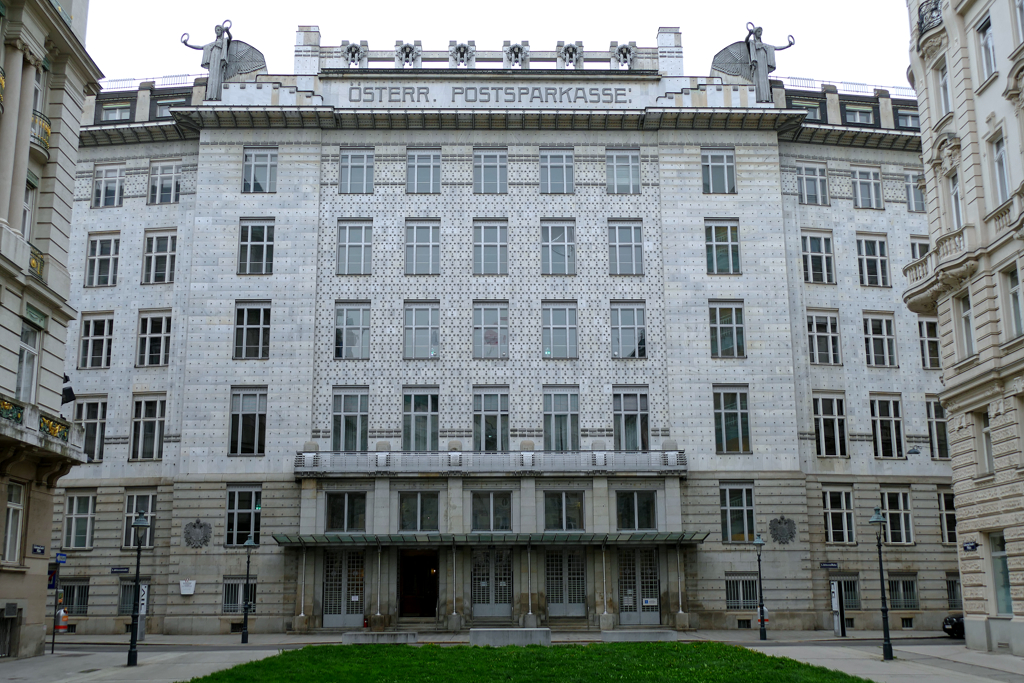
Its façade is covered in square marble panels and aluminum applications that are reminiscent of a money storage facility. Granite slabs are installed in the basement and upper floors. The rivets that appear to attach the marble cladding to the wall serve no practical function. They are purely ornamental and structure the façade. In reality, the plaster holds the approximately 10-centimeter-thick panels.
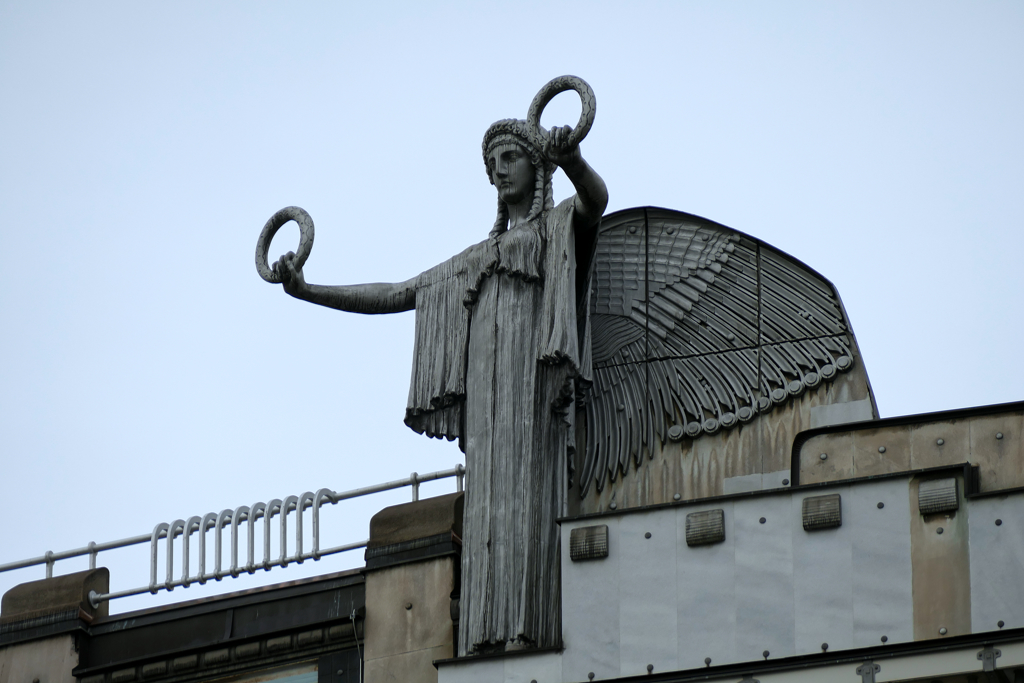
Since 2020, the building has housed campuses of various universities.
Government Building
An even more imposing structure is across the street from the Postal Savings Bank building. The double eagle attached to the roof gable alone is an incredible 16 meters wide! It symbolizes the armed power of the Danube Monarchy.
The building was completed in 1913 and then served as the War Ministry of the Austro-Hungarian Empire.

The ministry became obsolete with the collapse of the empire at the end of WWI 1918.
Various federal ministries have been using it since 1952.
On Beauty
At this point, as our circle tour nearly comes to an end, there are still three of the best highlights Vienna has to offer.
MAK – Museum of Applied Arts
Just one stop from the above-introduced majestic buildings is the MAK, the Museum of Applied Arts. During its founding year of 1852, the museum essentially followed the model of the South Kensington Museum which is now London’s Victoria & Albert Museum. It was intended to serve as a model collection for artists, craftspeople, and manufacturers as well as a training and further education center for designers.
In addition to its traditional focus on decorative arts and design, the venue also has a special emphasis on architecture and contemporary art. Among the most popular pieces are Klimt’s at the time of their creation controversial designs for the ceiling of the University of Vienna’s Great Hall. Today, an important goal of the MAK is art in public spaces.
In 1994, the MAK established a branch in Los Angeles which is housed in three buildings created by the Viennese architect Rudolph M. Schindler.
Since May 2017, the collection’s highlights can also be visited virtually on Google Arts & Culture. However, if you prefer to visit the galleries in person, you can do so for a general entrance fee of 16 €uros from Tuesday to Sunday between 10 a.m. and 6 p.m. However, on Tuesdays, they are closing only at 9 p.m.
Fun Fact
In 2015, the MAK was the first museum to purchase a work of art, namely van den Dorpel’s screensaver Event Listeners with Bitcoins.
Stadtpark
A so-called Wasserglacis on the edge of the city center was already a popular entertainment spot in the Biedermeier era at the beginning of the 19th century. When Vienna’s Ringstrasse was redesigned, a public park was created in its place. It was laid out in the style of an English park.
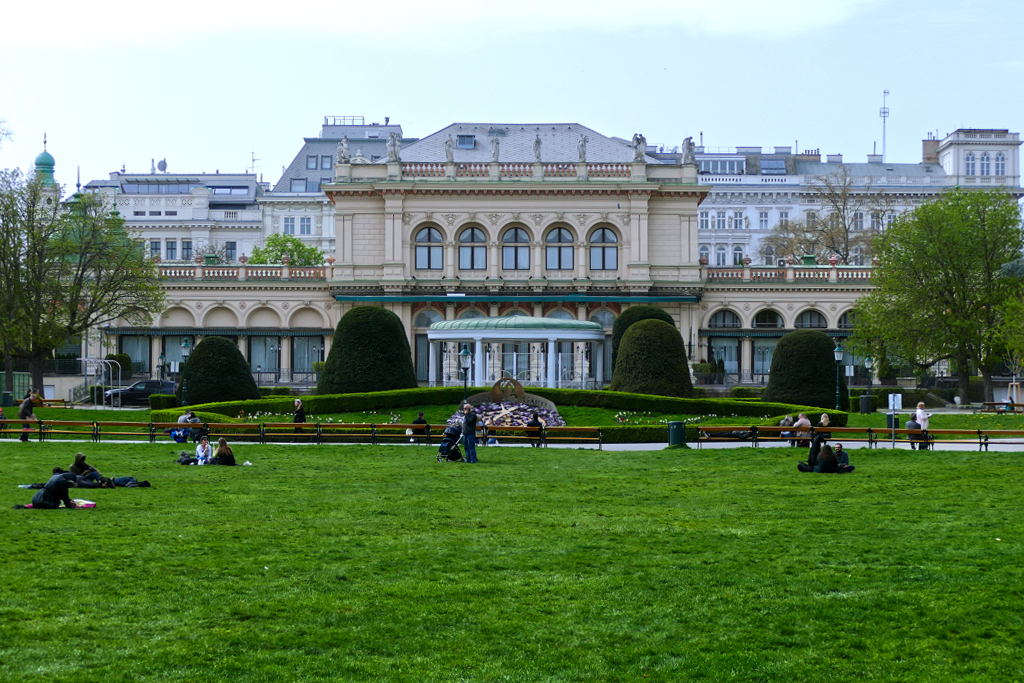
At the southern end, there is a magnificent historic building in the style of the Italian Renaissance. At the time of the Strauss brothers, this venue was a popular dance and concert hall. Today it is still a forum for balls, concerts, and clubbing. It also houses a café and restaurant should you crave a refreshment.

One of the most famous and most photographed monuments in Vienna is the gilded bronze statue of Johann Strauss. Also on the south side of the park is another subway station designed by Otto Wagner.
Belvedere
Lucas von Hildebrandt built the Belvedere Palace for Prince Eugene of Savoy between 1714 and 1723. Due to their location on a slope south of what was then the city, the two main parts are called the Upper and Lower Belvedere. A magnificent garden connects them so they form a baroque ensemble.
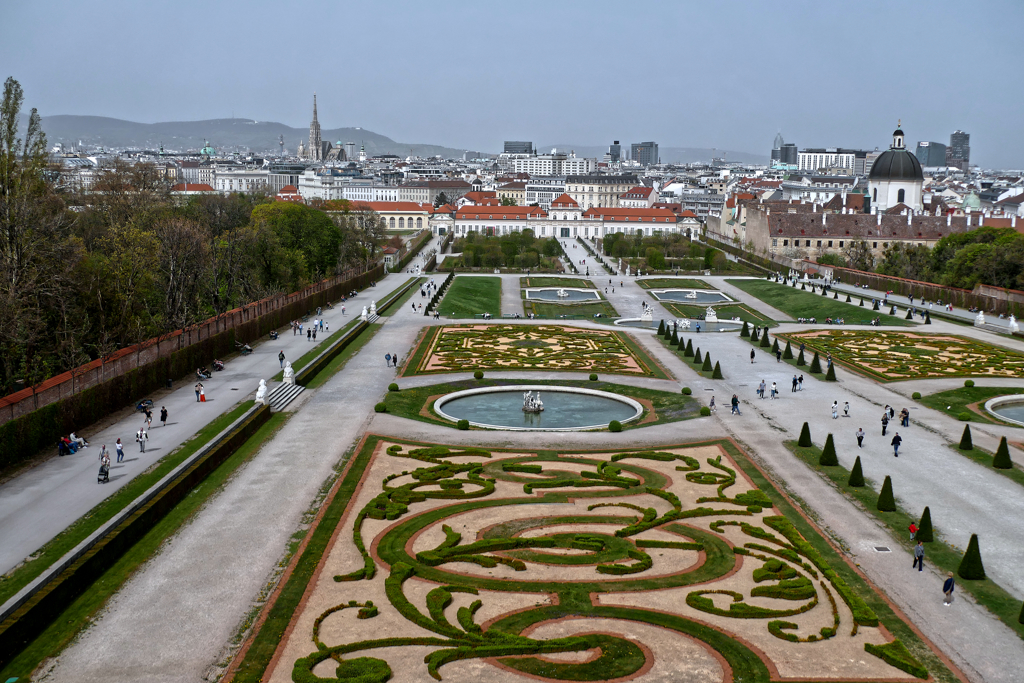
In fact, the garden is the oldest part of the complex, as it was created shortly after the property was purchased around 1700. Horticulture also included the water infrastructure. Prince Eugen had received permission to use the imperial court water pipe for the numerous fountains.

Since the Upper Belvedere is about 23 meters higher than the Lower Belvedere, the sculptures are arranged thematically on the rise from the underworld to Olympus.
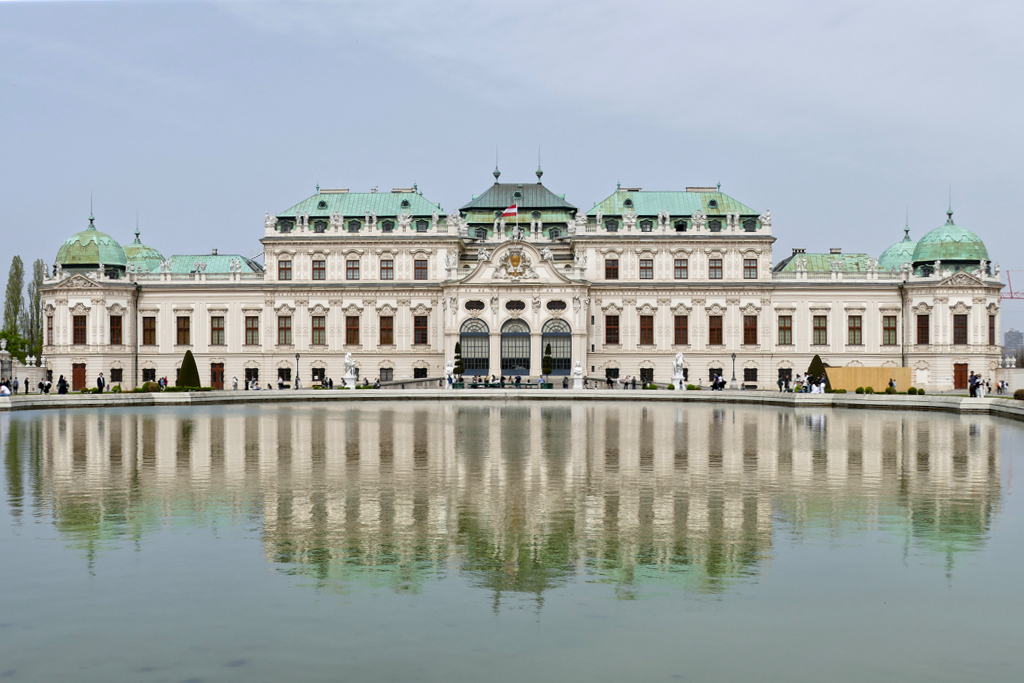
The entire complex has been open to the public since 1780.
Austria Has Talent
The two castle buildings now house exhibitions. While temporary exhibitions take place in the Lower Belvedere, the permanent collection in the Upper Belvedere is undoubtedly a must-see. Some of the most important works are shown, mainly by Austrian and German painters such as Gustav Klimt and Egon Schiele, but also Hans Makart and Hans von Marées, and many others.
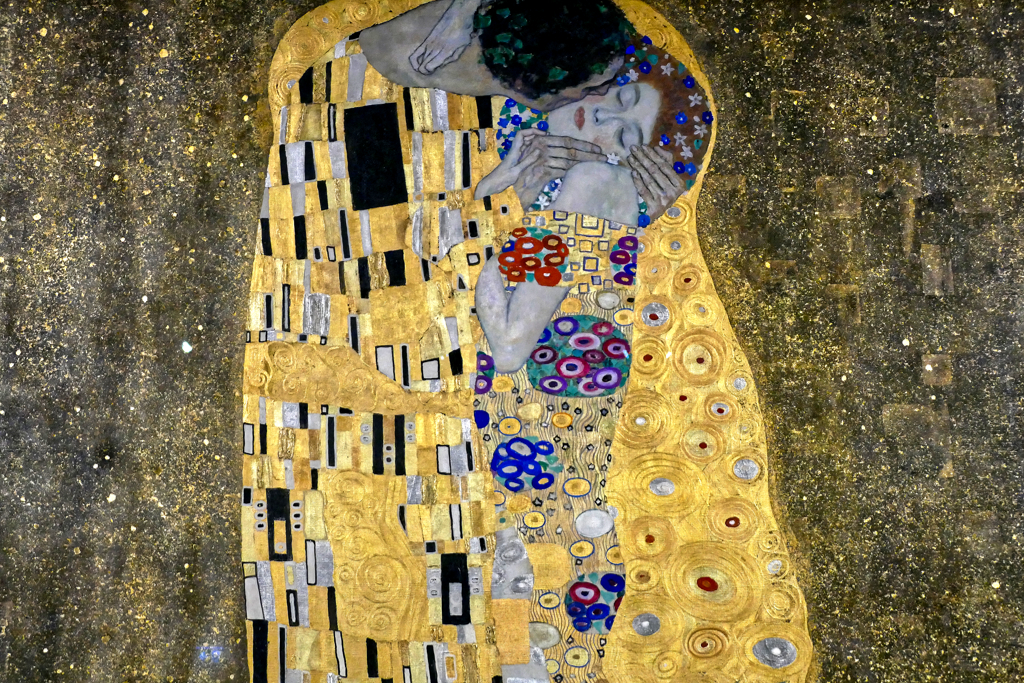
In 2011, Some years ago, the galleries were completed by the so-called House 21. It is located about 10 minutes north of the Belvedere and presents contemporary art. Also, the museum café in the House 21 is highly recommended.
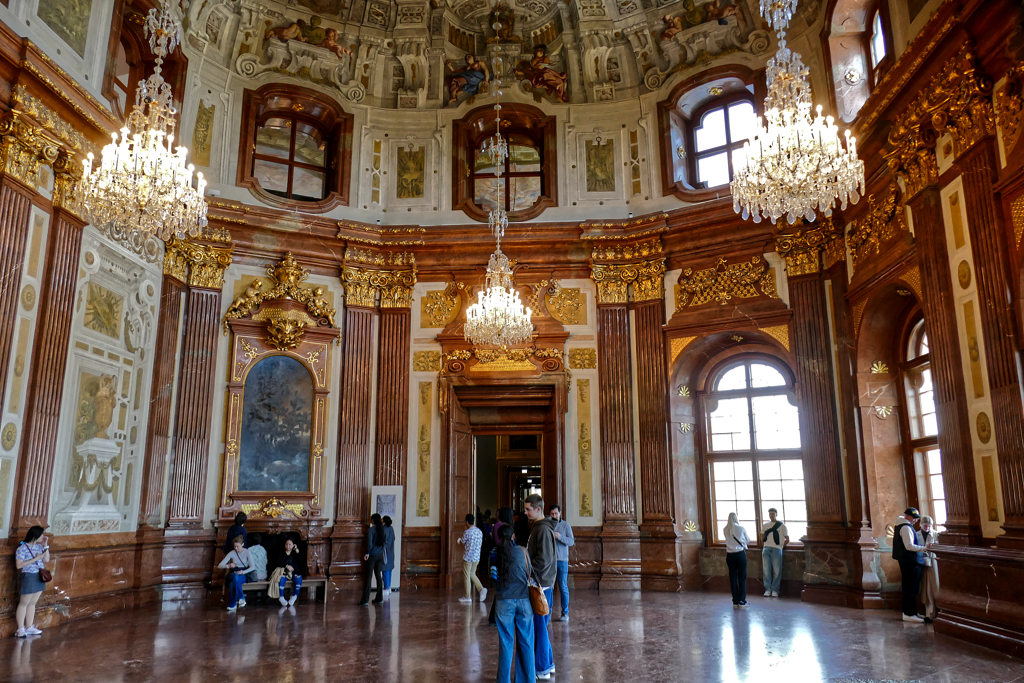
The Belvedere galleries are open daily from 9 a.m. to 6 p.m. The Upper Belvedere doesn’t close until 7 p.m. and a time slot must be booked to visit. The ticket costs 19 €uros. The ticket for the Lower Belvedere costs 17 €uros and the House 21 costs 11 €uros. You can save with a 2 for 1 respectively a 3 for 1 ticket. Plus, buying online is cheaper than in person.
Practical Information
How to Get There
By Plane
Vienna’s international airport is about 14 kilometers southeast of the city center.
Getting downtown from there is easy peasy, actually, there are four options. However, I recommend only one – unless you arrive at ungodly hours or have to schlepp very heavy luggage.

Take the so-called S-Bahn S7 towards Floridsdorf and get off at the stop Landstraße/Mitte. This train takes only about two minutes longer than the so-called CAT which is short for City Airport Train. Yet, a one-way ticket costs 4,40 €uro instead of a whopping 12 €uros that you have to pay for the CAT. There is also an airport bus for 8 €uros which is actually the least recommendable option. Finally, there are also cabs which will charge at least 30 €uros.
By Train
Austria lies in the center of Europe and can therefore easily and quickly be reached by train. Obviously, easiest and most quickly from neighboring countries such as Slovakia, the Czech Republic, and Switzerland. But even from Paris, you get there in about twelve hours.
Traveling by train with the Nighjet is particularly attractive. The ÖBB Nightjet is a very popular and environmentally friendly alternative to flying. The night train offers different categories of sleeping capsules in almost sophisticated compartments with showers. The cheapest category costs around 50 euros if you book well in advance. There are direct connections to more than 25 European cities such as La Spezia and Rome, Amsterdam and Brussels, Basel and Paris. In Germany, the Nightjet not only goes to Munich and Berlin, but all the way up to Hamburg in the very North!
So, what’s the catch?
On the one hand, not all routes are served daily, and on the other hand, the Nighjet can be the more expensive option if you don’t book in time.
However, it is still worth checking the connections online before buying a plane ticket.
By Long-Distance Bus
Travelling by long-distance bus is getting really popular in Europe. The cheap prices make up for the little loss of time compared to trains. And since various companies are competing, the service is usually very reliable.
One of the most popular bus companies in Europe is flixbus. They are connecting Vienna with over 250 European cities like Berlin, Prague, Warsaw, and many others.
There are five bus stations in Vienna. While some are on the outskirts, those at Karlsplatz and Westbahnhof couldn’t be located more conveniently.
How to Get Around
First of all, the very center of Vienna, hence, the old part within the so-called Ringstraße, is not very large and therefore easily walkable. However, some must-see attractions are outside this area. Also, you will probably walk a lot visiting Vienna’s iconic museums, and you’ll possibly stay a bit outside the very center.

To cut a long story short: You might need to travel by public transportation.
As in basically every European city, there is a comprehensive network of subways, trams, buses, and regional trains.

A single trip costs 2.40 €uros. With this ticket, you can travel for 80 minutes in one direction, hence, it’s not good for a return trip. However, for 80 minutes, you can hop on and off the streetcar #1 as well as #2 if you always continue in the same direction. That’s quite a bargain, don’t you think?
If you’re planning on taking the means of public transportation a lot, a day pass for 8 €uros is a good deal. Actually, you’ll find comprehensive information and a clear overview regarding discounts and deals in the section below.
Cycling
Cycling is a great way of exploring cities, and the public rental bikes that you’ll find practically in every larger city around Europe make things really easy and fun.
The city of Vienna has WienMobil bikes available for residents and visitors. The 3,000 rental bikes are waiting for you in all 23 districts of Vienna. The WienMobil bike is a 7-speed smart city bike with an integrated electronic frame lock. After registering for free, you can scan the QR code with the Next Bike App. The standard tariff is €0.60 per 30 minutes. Payment is made via credit card, Apple Pay, Google Pay or PayPal.
What to See
I’m an avid solo-travelling woman. Since solo-travel doesn’t equal solitude, I love to join organized tours here and there. Also, to make sure that Vienna’s attractions you intend to visit aren’t sold out you might want to book ahead. However, here are some ideas of what to do and how to visit Vienna in an easy way*:
Where to Sleep
In 2023, Vienna welcomed its second-largest number of visitors. This resulted in more than 17 million overnight stays. Hence, although there is a wide choice of lodging options, accommodation tends to be rather expensive.
Booking.comIt’s an easy equation: Of the three aspects of a good standard, convenient location, and affordable price, you always have to waive one. If you find a good standard hotel in a convenient location, it won’t be at an affordable price. A hotel in a convenient location at an affordable price won’t have a good standard. And finally, a good hotel at an affordable price won’t be in a convenient location.
Usually, I opt for the last option. But Vienna now has this amazing new hotel called JO&JOE*. It’s located right next to the centrally located Westbahnhof on top of – I kid you not – IKEA. The Swedish furniture store occupies the first four floors, then comes JO&JOE*.
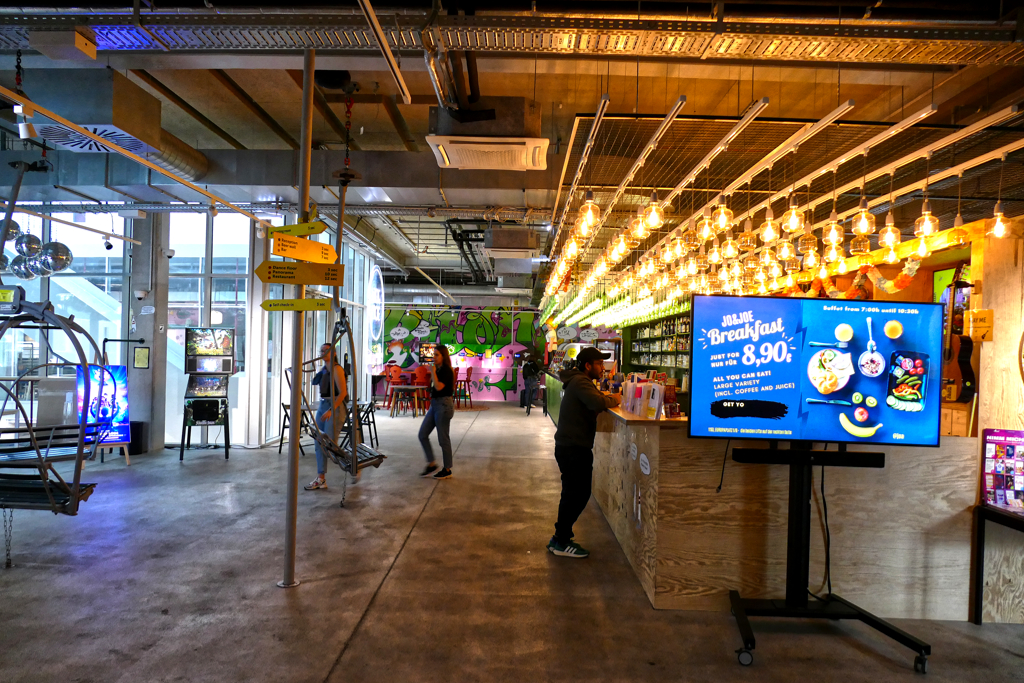
Following an environmentally friendly concept, the building is the fertile soil to more than 160 trees and bushes. It’s decorated with cool urban art, and on the 7th floor is one of Vienna’s largest rooftops with amazing views of the city and its mountainous outskirts. So if you are looking for a cool spot at a reasonable price, don’t search any further, book a room at JO&JOE*. And if you need a wooden shelf or have a craving for Swedish meatballs, you just need to go one floor down.
However, if they should be booked out or if you are simply looking for something different, you’ll find suitable lodging options in Vienna on this map*:
Booking.comWhat to Eat
Vienna is an internationally oriented city. So of course you will find all the world’s cuisines there. However, I assume and hope that you didn’t come to Vienna because of the world’s cuisines, but rather want to feast on local food.
Traditional Austrian food is very hearty, and due to the common past, it is similar to Czech and Hungarian cuisine. As a matter of fact, wealthy Austrian families often hired cooks from Bohemia during the Austro-Hungarian era. Vienna is famous for its savory, yet a bit heavy cuisine with lots of meats, dumplings, and fantastic desserts and cakes. Also, the variety of Viennese coffee specialties will make your head spin!
Beisl
A Beisl is an Austrian pub or inn. Since the term is only used in Austria, one automatically associates all the traditional hearty dishes such as goulash, schnitzel, and roast meat, but also delicacies such as Palatschinken, crispy pancakes.
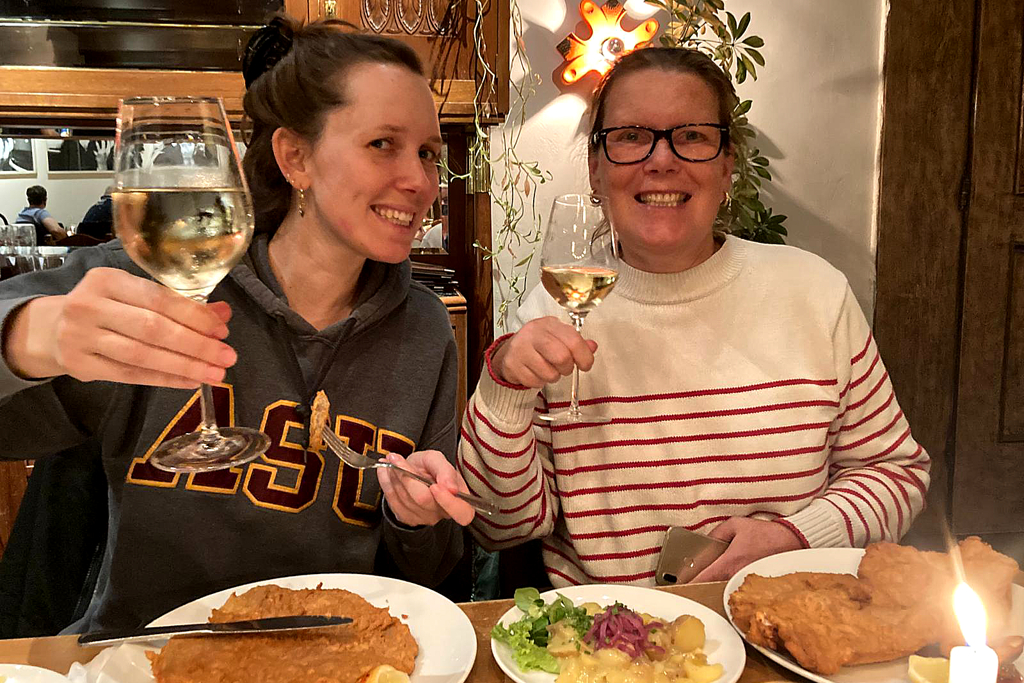
There are now restaurants, especially in the city center, that appear to be traditional. Yet, they offer mediocre cuisine at inflated tourist prices. Nevertheless, the authentic Beisl still exist where at times a surprisingly grumpy waitress serves you amazing dishes at a very reasonable price. Make sure to try the food in one of the Reinthaler branches. Then, I can also highly recommend Café Eiles, and if you’re willing to leave the immediate city center area, you’ll leave the restaurant Mader with a full stomach and a happy heart.
- Gasthaus Reinthaler is open on weekdays from 11 a.m. and 11 p.m.
- Reinthaler’s Beisl is open every day from 11 a.m. to 11 p.m.
- Café Eiles is open on weekdays from 7 a.m. until midnight. On weekends, they open only at 8 a.m.
- Restaurant Mader is open from Wednesday to Friday from 5 p.m. to 11 p.m. On Saturdays, they open already at 11.30 a.m. and on Sundays, they are only open from 11.30 a.m. to 4 p.m.
You’ll find the exact locations and addresses on the map below.
Snack Bars
If you only want to grab a quick snack, there are quite a few great options. A highly popular classic is the Bitzinger Sausage Stand right in front of the Albertina gallery behind the opera. But go there in time before you are really hungry since the linen can get very long. After all, that’s only proof of their quality at a fair price.
The stand is open every day from 8 a.m. to 3 a.m.
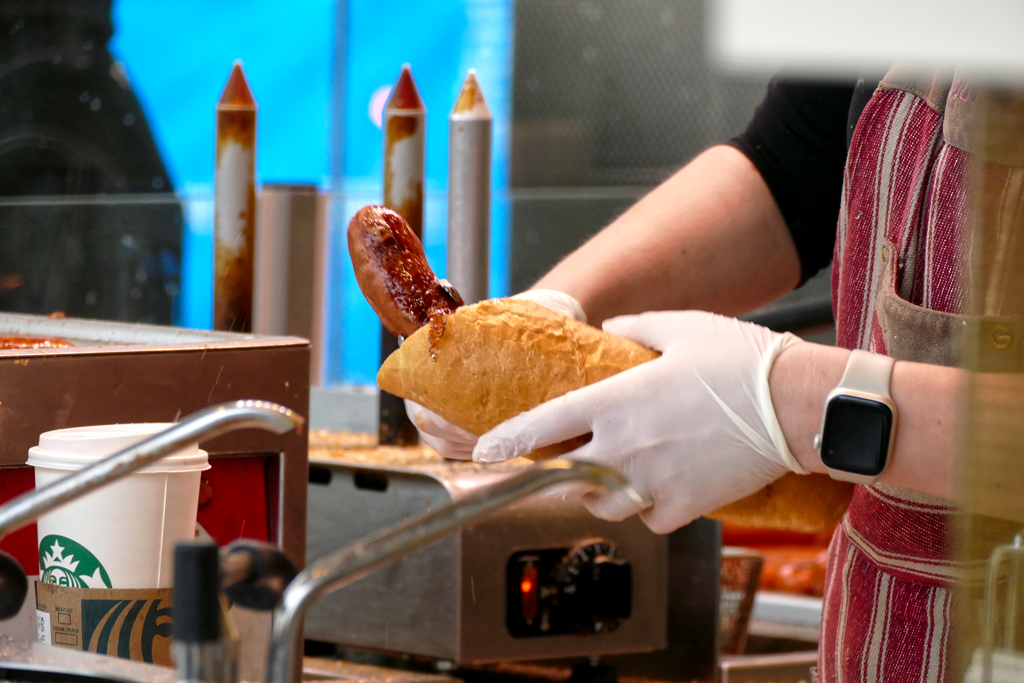
A very unique snack bar is Trzesniewski. Don’t know how to pronounce it? Never mind, even Vienneses don’t, hence, they put it in their slogan: Trzesniewski – unspeakably good.
Their specialty are small open-faced sandwiches with all kinds of hearty spreads. Whether meat or fish-based, whether with herbs or veggie: Trzesniewski’s small sandwiches are delicious, indeed. Try them accompanied by a so-called Pfiff, hence, a tiny glass of beer, or a glass of Austrian wine.

They have a couple of branches all over town, but my favorite is at the Dorotheergasse which opens weekdays from 8.30 a.m. to 7.30 p.m., on Saturdays from 9 a.m. to 6 p.m. 19.30, and Sundays from 10 a.m. to 5 p.m.
Coffeehouses
If you want to adopt authentic Viennese lifestyle, come to a Kaffeehaus later in the morning. Bring a book or notepad with you or take one of the newspapers on display. Then, sit at one of the small tables. Order a coffee specialty and stay idly in that very spot until the night falls.
Look at you, becoming one of us!
Arguably Vienna’s most prestigious café is Landtmann across the road from the town hall. However, not only is it crazy expensive, I’ve also heard that they simply ignore customers who do not fit what they consider appropriate.
Since there are around 1050 cafés in Vienna, you really don’t have to put up with their snobism.
Nevertheless, they look down on their customers every day from 7.30 a.m. until midnight.
Not snobbish, yet a real Vienna institution is the Café Hawelka. Elias Canetti, Andy Warhol, and Sir Peter Ustinov are only three international stars from a long list of celebrities who took pleasure in Hawelka’s hospitality.
You can enjoy their specially roasted artisan coffee from Monday to Thursday between 8 a.m. and midnight. Fridays and Saturdays, they are closing only at 1 a.m., and on Sundays, they open only at 10 a.m. However, you can also order the beans from their online store.

One of my favorite cafés is the Café Tirolerhof. The building was commissioned by the silk manufacturer Eduard Friedmann in 1885.
From the very beginning, there has been a restaurant on the ground floor. However, first it was a dairy. It was then converted into today’s typical Viennese coffee house in 1918. Hence, it kept its incomparable vibe for 106 years by now.
They are open from Monday to Saturday between 8 a.m. and 9 p.m., on Sundays, they only open from 9.30 a.m. to 8 p.m.
Cash And Cards
Until now, 20 European countries replaced their former local currency with the €uro starting in 2002. Obviously, Austria is one of them. The exchange rate is 1 US$ = 0.92 EUR as of May 2024. However, you can check today’s conversion rate on this page.
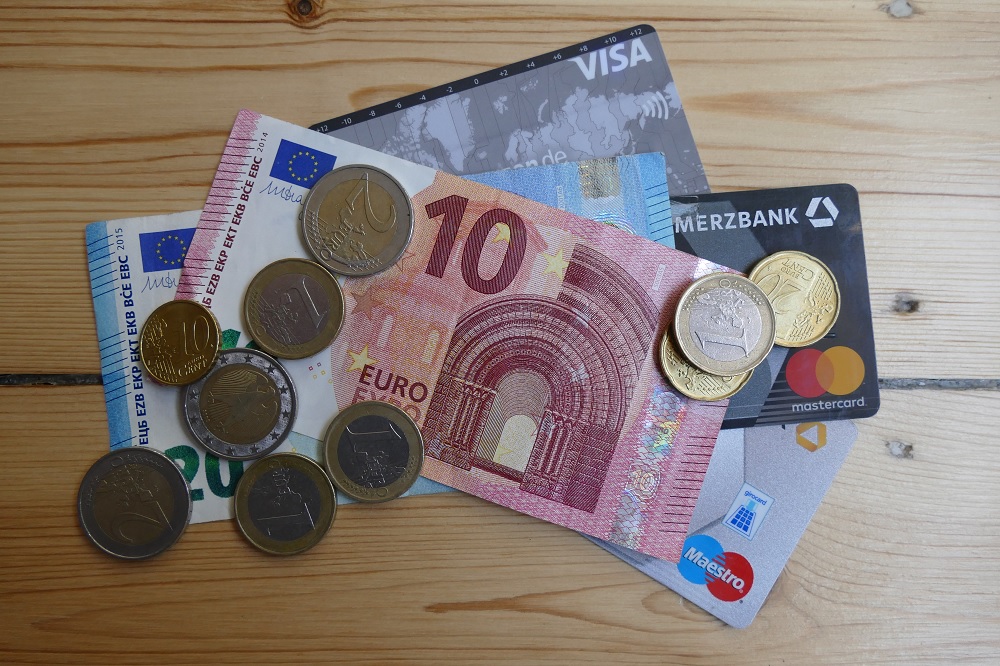
Especially since the pandemic, cards are far more accepted than before.
Deals And Discounts
Whatever you have planned, you might be better off with a tourist pass. In Vienna, there are three types of passes: The Vienna City Card* which grants you free use of transportation and discounted entrance to many attractions, as well as the Vienna Pass and the Flexi Pass for two to five attractions. The passes grant you free access but no free use of transportation so you need to buy an additional travel card.
Since the choice is yours, obviously, I’m giving you a comprehensive overview so you can do the maths:
| 24 hours | 48 hours | 72 hours | |
| 17 €uros | 25 €uros | 29 €uros |
You can add a 24-hour hop-on hop-off option for 31 €uros as well as Airport Transfer for 22 €uros. If you follow my guide, you don’t need either of those.
| 24 hours | 48 hours | 72 hours | 144 hours |
| 80 €uros | 114 €uros | 142 €uros | 179 €uros |
| 24 hours | 48 hours | 72 hours | |
| 8 €uros | 14.10 €uros | 17.10 €uros |
One child up to the age of six years can accompany a holder of a Vienna Pass for free. The pass costs half price for children and teenagers aged 6 to 18 years.
Finally, there is also the so-called Flexi Pass. This gives you free entry to a number of attractions of your choice. It is valid for 60 days from the first use.
| 2 attractions | 3 attractions | 4 attractions | 5 attractions |
| 44 €uros | 60 €uros | 76 €uros | 89 €uros |
Conclusion
Which passes are worth it for you depends primarily on your interests. Personally, I would say that although it seems very expensive at first glance, the Vienna Pass is the best deal if you really want to visit a lot of museums and landmarks. In my opinion, the Flexi Pass only pays off in its most expensive version, where you pay for five attractions an average price of 17.80 €uros.
Communication And Connection
Since June 2017, no roaming charges apply within the EU if you have a European mobile phone contract. This involves all 27 countries of the European Union as well as Iceland, Liechtenstein, and Norway.
The EU roaming regulation applies to all contracts.
In case European roaming is not available, you can connect to the internet at museums, eateries or cafés, and, of course, hotels. However, if you depend on a reliable online connection, you should opt for a SIM card. Whether phone companies such as A1, T-Mobile, or Drei or supermarkets like Lidl and Hofer – there is a wide choice of providers of prepaid cards.
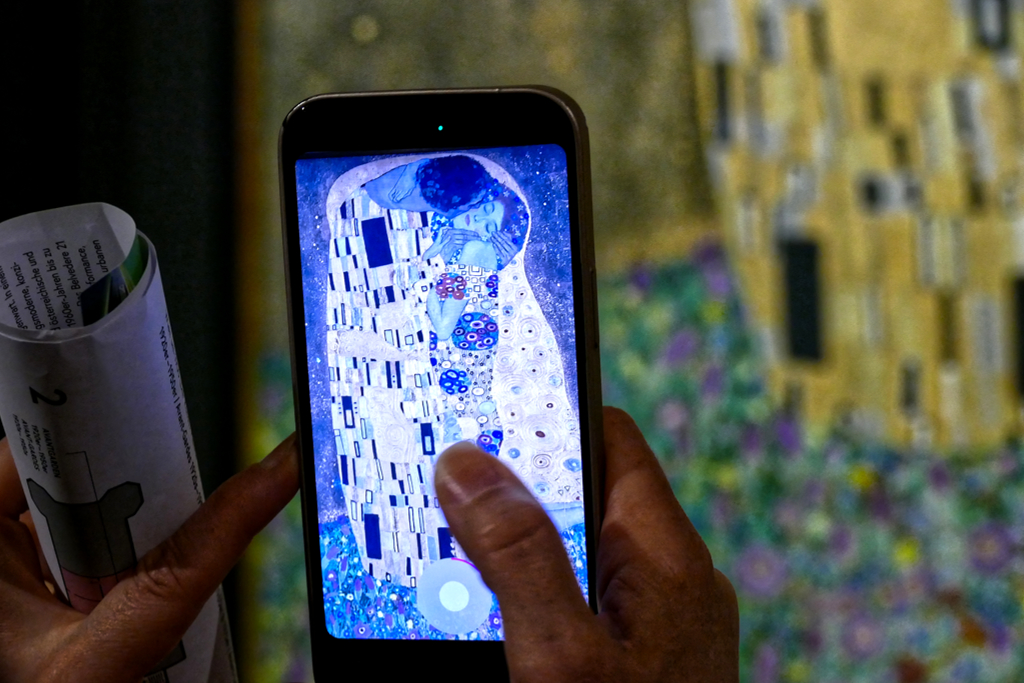
In Austria, they use plug types C and F. The standard voltage is 220 V and the frequency 50 Hz. Whereby, nowadays, all these chargers have integrated adapters so that the voltage and frequency don’t really matter.
By the way, you’ll find comprehensive travel info in my post World’s Most Complete Travel Information – an indispensable globetrotter-classic.
Say It Right
Austrians speak German with a strong accent and a peculiar dialect which might frustrate you if your German is only basic. Especially at the beginning of your stay, you might have some difficulties understanding people.
However, there are so many tourists coming here every year that most people speak pretty decent English or even other foreign languages. Nevertheless, for some useful words and phrases, you might want to practice a little with the help of e. g. Babbel. Also, the first lesson is free and already supplies you with a useful basic vocabulary.
In this post, I’m writing out some of the German names of brands and places. Obviously, you will notice that there are letters that might not exist in other languages.
Firstly, there is the letter ß which exists only in the German alphabet. It’s by no means a B – it’s a so-called sharp S. You pronounce it like the double S in kiss. So although the German word for street, Straße, looks quite exotic, it is simply pronounced Shtrasse. Mind you, when an S stands before a T, it becomes sh instead of s.
Then, there are three more vowels, ä being the easiest one since it’s pronounced like an open e as in head.
For some foreigners, ö and ü might be a bit tougher. Ö is pronounced more or less like the e in her. Finally, Ü sounds a bit like the u in huge.
If you have only a day in Austria’s mesmerizing capital, this helpful 24 hours in Vienna post provides a perfect itinerary.
And if you want to see an unexpected side of Vienna, make sure to check out my post Best Street Art in Vienna.
Map
On this map, you’ll find all the wonderful places I’m introducing in this post.
Clicking on the slider symbol at the top left or the full-screen icon at the top right will display the whole map including the legend.
Pinnable Pictures
If you choose to pin this post, please use one of these pictures:
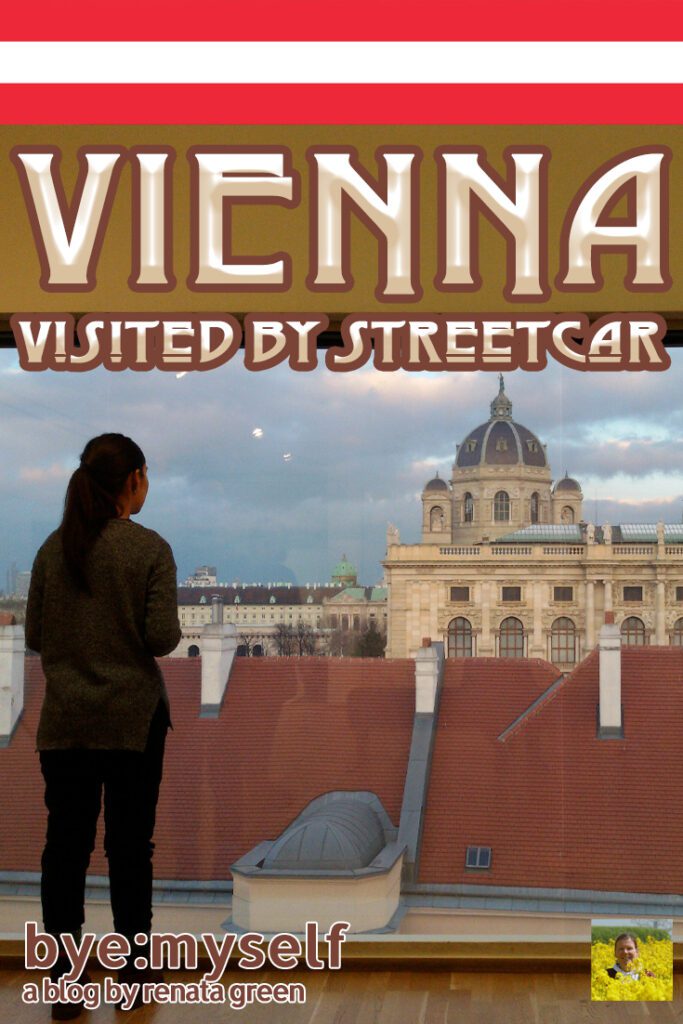
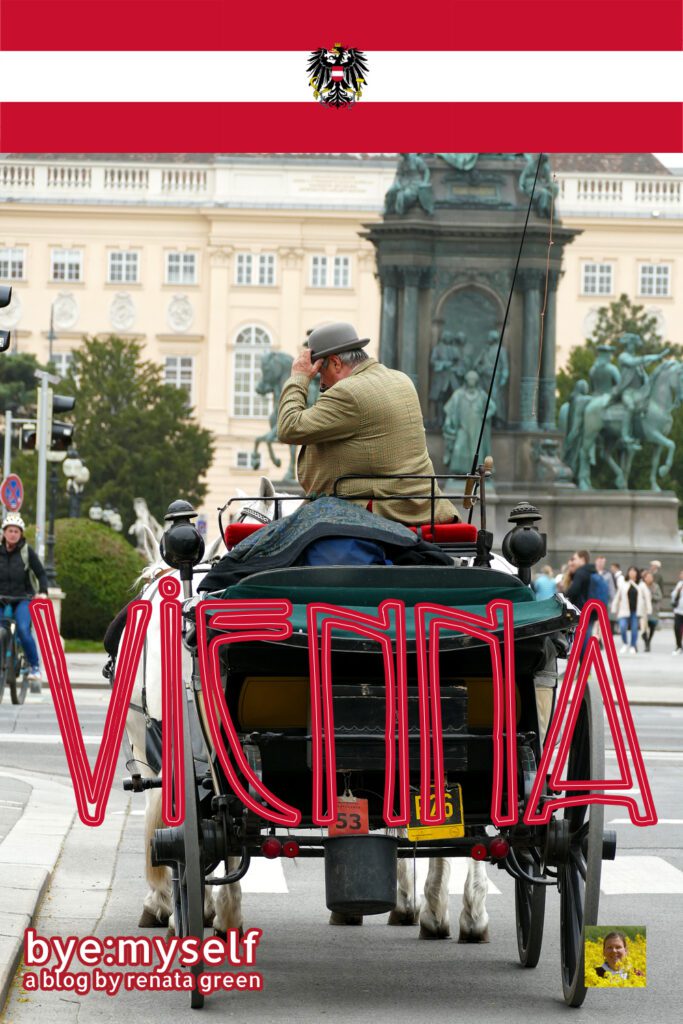
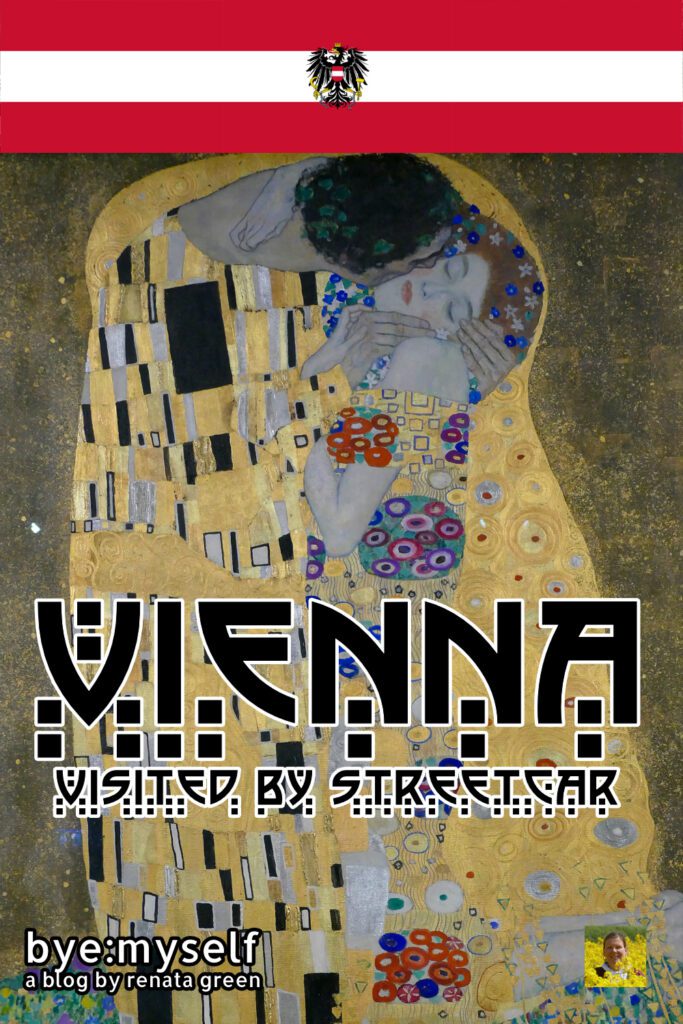
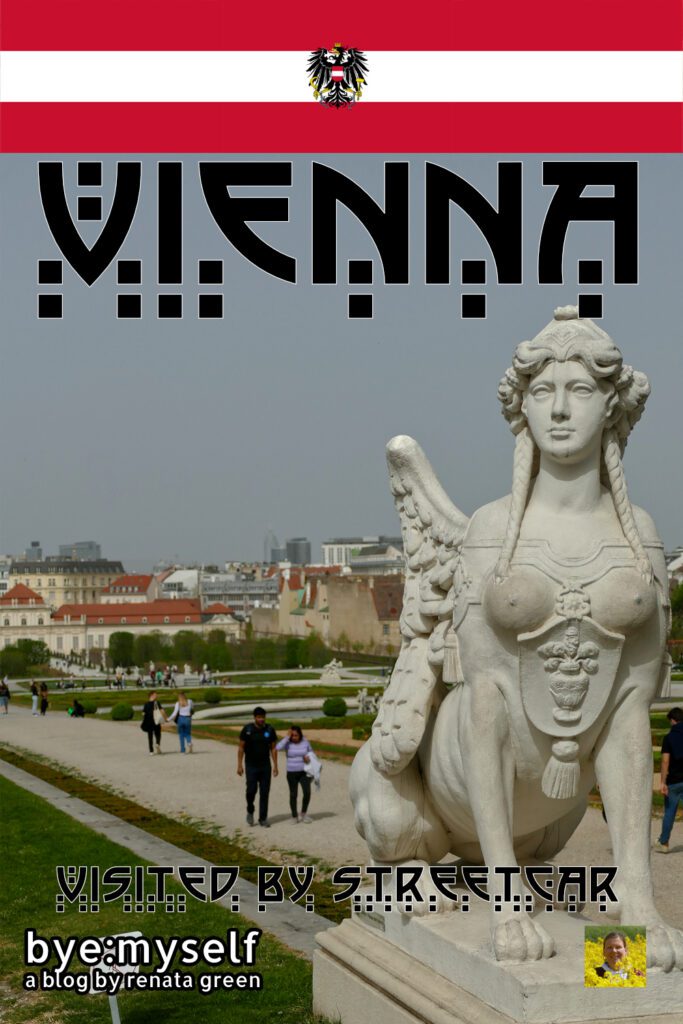
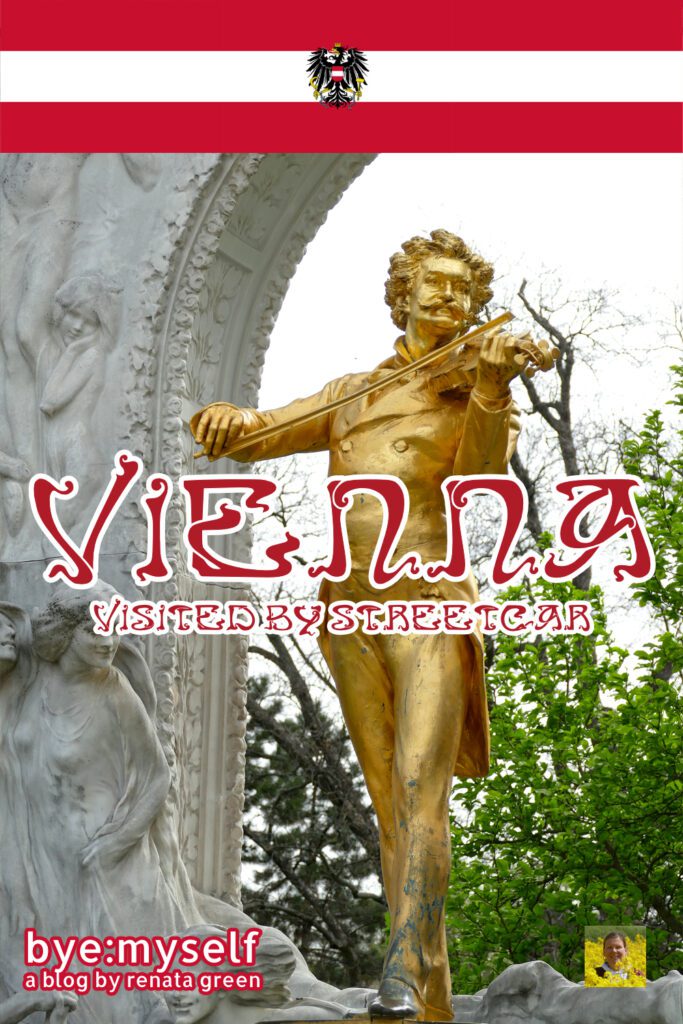
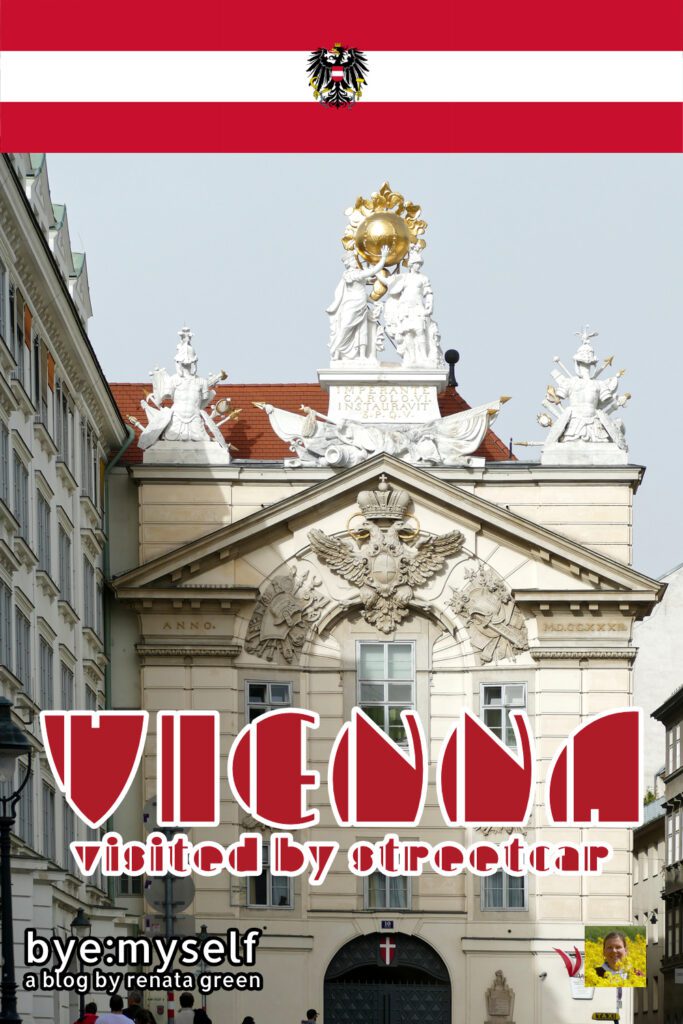
Note: I’ve thoroughly completed, edited, and updated this post in May 2024.
Did You Enjoy This Post? Then You Might Like Also These:
24 hours in HAMBURG
Guide to PUERTO DE LA CRUZ – a Town Full of Contrasts
LA GOMERA – How to Explore the Canaries’ Ravishing Wild Child by Public Bus
24 hours in AMSTERDAM
Guide to SPLIT, a city that has it all
Best Things to Do in BRUSSELS, the Capital of Europe
Rocking it in METEORA: Monasteries and Beyond
TAGANANA – Over The Hills And Far Away in Tenerife
* This is an affiliate link, obviously. Hence, in case you book through this page, not only do you get the best deal. I also get a small commission that helps me run this blog. Thank you so much for supporting me!
Disclaimer: Vienna Tourist Board supported my trip with complimentary 72-hours Vienna City Cards. Nevertheless, the description and all opinions on their services are mine and were in no way influenced by my cooperation partner.
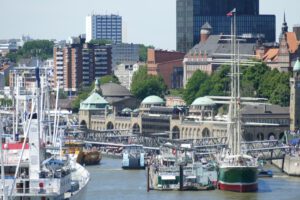
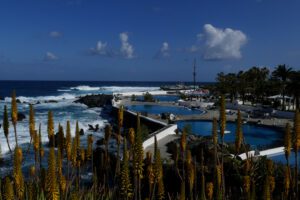
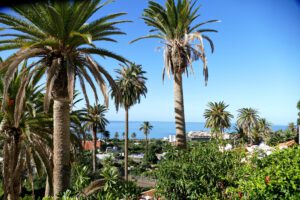
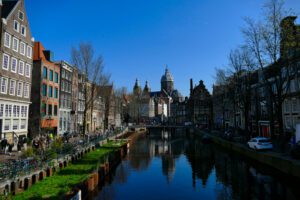
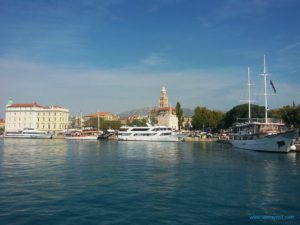
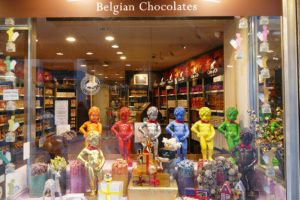
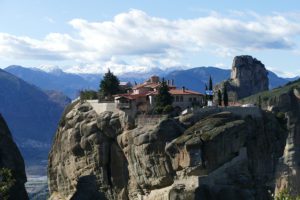
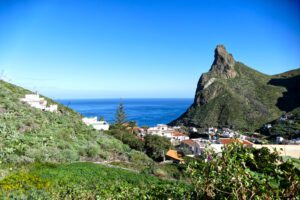
I have read some excellent tips here. Definitely bookmarking for revisiting. I wonder how much effort you put to make the sort of excellent informative travel guides.
Thank you for your appreciative words – yes, it takes a lot of time and effort, however, it’s all worth it 😉
Thanks for ones marvelous posting! I certainly enjoyed reading it, you can be a great author.I will always bookmark your blog and will often come back very soon. I want to encourage you
to definitely continue your great posts, have a nice afternoon!
Thank you for your kind words – I deeply appreciate your encouragement 🙂
We certainly found public transit to be an easy way to get around in Vienna. A great idea to use the Bims streetcar to see some of the great sights in the city. And to get off regularly for the great cafes and treats. Brings back such great memories. Although we need to spend more time in the museums on a return visit.
Hi! I just wish to give you a big thumbs up for the excellent information on a city trip to Vienna you have got right here on this post.
I’m so glad you like it. Have a great trip to Vienna 🙂
You need to take part in a contest for one of the best travel sites
on the internet. I most certainly will recommend this web site!
Thank you, that’s so sweet of you 🙂
Thanks very nice blog!
You seem to know so much about this, like you wrote the book on it or something. I think that you can do with a few pics to drive
the message home a bit, but instead of that,
this is a wonderful blog. A fantastic read. I’ll definitely be back.
I guess you’re right- on my next trip to Vienna, I’ll take tons of pix to publish in this post 😉
A long weekend in Vienna the weekend before Christmas has become a Jetset Boyz annual event. Vienna’s prettiest squares transform into magical Christmas markets. The aroma of Christmas baking & hot punch sets the mood in the run-up to Christmas.
Last year there were fourteen different markets – you’re absolutely spoilt for choice and you’ll feel like a kiddy in a sweet shop! So, if you’ve never been to Vienna in December why not make a plan!?
Well, I’m based in Germany, yet I’m not a fan of Christmas markets. However, it surprises me that there were Christmas markets open during the pandemic. My friends from Vienna said it was pretty much locked down….
I was very happy to find this site. I want to
to thank you for one time for this particularly wonderful read!!
I definitely appreciated every bit of it and I have you bookmarked to
check out new information in your site.
I have learn several excellent stuff here. Definitely worth bookmarking for
revisiting. I surprise how a lot effort you set to make such a great informative website. https://anunturi-parbrize.ro/index.php?cauta=parbriz+kia
Thanx so much – I’m glad you appreciate my hard work 😉
Pretty! This has been a really wonderful article. Thank
you for providing this guide.
I enjoy your writing style really loving this web
site.
I was supposed to be in Vienna this summer, but due to the quarantine the trip had to be canceled. I’m upset because I’m still in the “red” zone …
Superb photos, the colour and depth of the pictures are breath-taking,
they draw you in as though you belong of the make-up. https://Ruay.club/
Amazing trip. They don’t only have beautiful natures but also buildings. I would love to visit it and experince everything in real life.
It’s funny you write a post about Vienna because Innsbruck is my dream city to live in, in Austria. Just love the amalgamation of nature, history, weather and hospitality. Would love to explore Vienna too!
Wow it looks so beautiful! I never knew there was so much to do and see here! wow I hope we get the chance to visit Vienna once the crisis is over! I love how charming the city is!
Haist! Can’t wait to travel as normal again, we opted not to travel outside U.K. at the moment because we have a wee one and for our peace of mind that we won’t catch any virus during this pandemic. Anyway, Vienna is in our bucket list as my friend’s auntie lives there, we wanted to visit her as well. I wanna try to travel by car in Europe but my husband is not confident doing it and I don’t drive so we always end up doing public transportation which is great as well to try and see the places and experience the country’s local transport network. Also, we do try those tourist cards. Will bookmarked this for our Vienna trip.
I’ve only seen Vienna from the inside of the airport actually. But seeing these amazing pictures from Vienna, really makes me wanna go and explore this stunning city. I had no idea that they had such beautiful architecture! Looks like a lovely city to just walk around and enjoy stunning views, eat great food and take lots of beautiful pictures.
Vienna is absolutely stunning and your pictures are amazing! It really does sound like taking the tram is a great option when visiting because it’s crazy affordable and you get to see so much! I’d love to go to the Spanish riding school and watch some of those training exercises in the morning and the Belvedere sounds like it would be worth a few days of wandering around in alone!
OMG Vienna is full of Victorian museums that I would love to visit! No need for further explaination, I am sold! Vienna wait for me 🙂
It seems like that I am travelling the world through great post like yours. Thanks for sharing with me.
This has to be the most beautiful city I have ever seen. Thank you for sharing.
Wow! What a beautiful place with an immersive culture to experience. Thanks for sharing!
This article is very detailed and informative. Vienna is such a beautiful city. They have a lot of beautiful cultural values.
Your post on Vienna is very detailed and informative. I loved that you included each and every details and not missed any thing for first timers and even for repeat visitors. I loved Vienna and its cultural vibes.
this place looks truly amazing through your images and writing…..
It's really nuts to consider the incredible density of history Vienna offers. From science, art, war, modern film, and more dating back to antiquity. I love how you lay out the contrast between the romanticized Vienna most are accustomed to (e.g. Before Sunrise) and the sinister side that is present. I have always wanted to visit and when I do I will remember and re-visit this post. You write beautifully and informatively. Lastly, I'm with you on Team Self-Guided tours. Do your research beforehand and explore freely. Love it.
Very informative post on Vienna, a city I hadn't given much thought to visiting but you may have changed my mind on that!
I've only been to Vienna once, and it was only for 2 days. We mainly hit the big tourist stops like the Belvedere, Hofburg, and Schönbrunn. I'd love to go back and take my daughter who is finishing her master's in art history. We would love all of these art exhibits!
Thank you for such an informative post !! Vienna is definitely one of those destination bucket list places for me. 🙂
Thanks for sharing this amazing post. Vienna has so much history. Definitely looking to head there for the museums and the food.
I love how detailed and organized this post is! Now if I ever want to visit, I have the perfect guide!
Looks like an incredible place to visit. I love all the details you provided for first-time visitors.
Wow thanks for a very insightful post. I will definitely be adding to the list of places to visit!
The Art Nouveau facades are stunning and you're seriously so lucky you get to visit every year! The yellow Ring-Tram sounds quite cute actually. The Vienna pass sounds a little expensive but I think I'll get both tourist cards though just in case. Plus if I'm there already, I might as well commit and take advantage of the deals right?
Vienna is one of my bucket list. it's such a beautiful city.
I've always wanted to go to Vienna but was sold after you said they were famous for their desserts and cakes! That's for sharing you insights.
Great, in depth post. I never went to Vienna but it's obvious I missed out on a lot, your beautiful pictures capture the spirit of the place and its rich history.
I had no idea Egon Schiele was from Vienna, his art is amazing. Love the art photos you shared here as well as Kahlenberg, I would definetely want to visit that forest.
I'd love to go to Vienna to learn German! I took up one-semester-long course of this language because of my university professor, and I fell in love with it! That Ferris Wheel photo looks spectacular. I can't imagine how scary it appeared in the film that you mentioned.
This was a very thorough review of Vienna. I have read some material on Vienna before but nothing like this. The streetcars seem pretty useful and don't cost to much. I like the Vienna pass as it reminds me of the Eurail Pass. I have always thought about Vienna as old world and charming.
I have never visited Vienna but my husband has and we are planning to visit this city together for a long time. I loved your post and fell in love with the beauty and culture of this place all over again.
Vienna is a city that has a distinctive old world charm which is so alluring. The city has such a classic appeal with its rich heritage, culture, its monuments and museums.Visiting the city in a street car sounds really fascinating. Your post has some exhaustive information that would be of immense use to first timers in Vienna.
I absolutely love Vienna! All of your pictures are amazing and you hit all of the main attractions plus more! I would love to go back someday 🙂
Vienna sounds amazing! When I was last in Europe I did not visit Vienna, but would love to someday. It sounds like an amazing experience, and so rich in historical significance as well!
Wow it looks amazing. Some of those museums look quirky!
I definitely have to go Vienna in the near future, it looks fabulous! I love your photos and thank you for the info too! (I'll feel more prepared now!
Gorgeous! I would love to visit VIenna. Those travel cards are very helpful to know about!
How beatiful Vienna is, I have my eye on Vienna all through 2017, hope I get to cover it this new year! The photos are amazing.
You have nicely brought up the beauty of Vienna within this place. The photographs are stunning and it seems to have lots of places to explore in Vienna.
What a thorough guide to Vienna. Since we have decided to go to Vienna next year, I have sent this to my email so I can refer to it. It is such a well-written wonderful comprehensive guide with great photos! Couldn't ask for anything more. You know Vienna!
I have been once really too fast, less than 24 hours so I cannot say I know vienna and i need to come back. no time to see museum and it looks like there are so many. interesting.
This is an extremely detailed post and very useful. We hope to travel to Vienna at the end of the year so will book mark this post. I love the Art Nouveau facades they are so beautiful and the city is so historic.
Vienna looks incredible! The fat house had me giggling! I've added this to my bucket list!
Vienna is one of those magical places. And this is a great guide! We love to tour like locals (is there such a thing lol) so doing it by streetcar fits the bill.
How gorgeous! I love the beautiful colors, and that "fat house" is so whimsical!
WOW! This post is so thorough. I've never been to Vienna but when I do visit, I'll be sure to reference this. The chart was helpful!
You truly enjoyed your trip to Vienna! It surely is a very beautiful city to begin with. Also, all of your photos are stunning! Truly captured the beauty of the place and people.
Wow! This is a very comprehensive guide to Vienna. I so want to visit now!
Looks like a great place to visit. I have never been here and wouldn't mind exploring.
Wow, great information! You really were able to experience a lot there. Great post to revisit when planning a trip to the area!
Wow I have never really thought about going to Vienna before but it looks amazing!! I love places we can explore and especially with historical sites, it looks like such a wonderful place!
Oh goodness! Vienna is absolutely gorgeous! The pictures look too cute. I love visiting historical places, learning about ancient history feels so nice. And a trip round Vienna in a street car sounds nice. Hope I get to visit Vienna someday!
Oh goodness! Vienna is absolutely gorgeous! The pictures look too cute. I love visiting historical places, learning about ancient history feels so nice. And a trip round Vienna in a street car sounds nice. Hope I get to visit Vienna someday!
I have never been to Vienna nor I must admit albeit reluctantly ever considered adding Vienna to my list. However good food, history and art are always prerequisites that I use to scout out future travel spots and the Belvedere looks fabulous x
I'm absolutely loving this. I knew Vienna was pretty, and I've spent a weekend there before. But I had no idea just how much there is to do there, nor how much of it would be high on my list of things I love to do. Although perhaps not the eating, which would seem to require mightily deep pockets. The tram looks like a great way to orientate yourself, and like in London, the ordinary version rather than the tourist option will show you loads for a lot less cash. I'm inspired to add this to my list of places to visit this year.
Beautiful photos, Vienna is on my wish list. I really must visit one day.
These photos are amazing!! My parents love Vienna, I cannot wait to go
Very informative post on Wien. I love that city and seeing some of the photos here sure brought back good memories. I really need to go back there.
Wow, what vibrant photos and a really helpful post. I would love to visit Vienna, especially for the Schnitzel 😉
Cristina x
What an absolutely stunning place, your photos are gorgeous! Vienna has always been one of my top places to want to visit. I'd especially love to visit at Christmas time. This is such an informative article and I will definitely use it when planning my trip. Nikki
i always want to go to vienna.. in fact, my ex boyfriend currently lives there. 😀
i heard about how the christmas market in austria is one of the best in europe, so yeah.. it's always been on my bucket list.
but i am more interested to it because of its culture and history. i mean, i really want to see the place where hitler was born. in fact, thank you so much for mentioning the third man. so maybe next time i'll try to find the movie and watch it to get a glimpse of vienna after war. 🙂
I've never been to Vienna. But I had a really good friend my junior year of high school who was an exchange student from Austria. So that's as close as I've gotten. This is a really thorough write-up of what to expect while visiting Vienna.
Loved reading your post. It reminded me of our trip to Vienna back in 2016. Loved the place especially the hofburg palace.
Vienna is so beautiful! My favorite place that you mentioned that I would want to visit someday is the Wienerwald, the Vienna forest! The view/pictures are just amazing! Beautiful. Also, I LOVE the Art Nouveau facades on the buildings that you show in the pictures. I love how intricate and how beautiful they are. 🙂 Thank you so much for sharing!